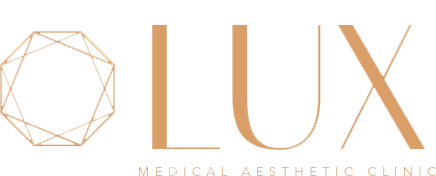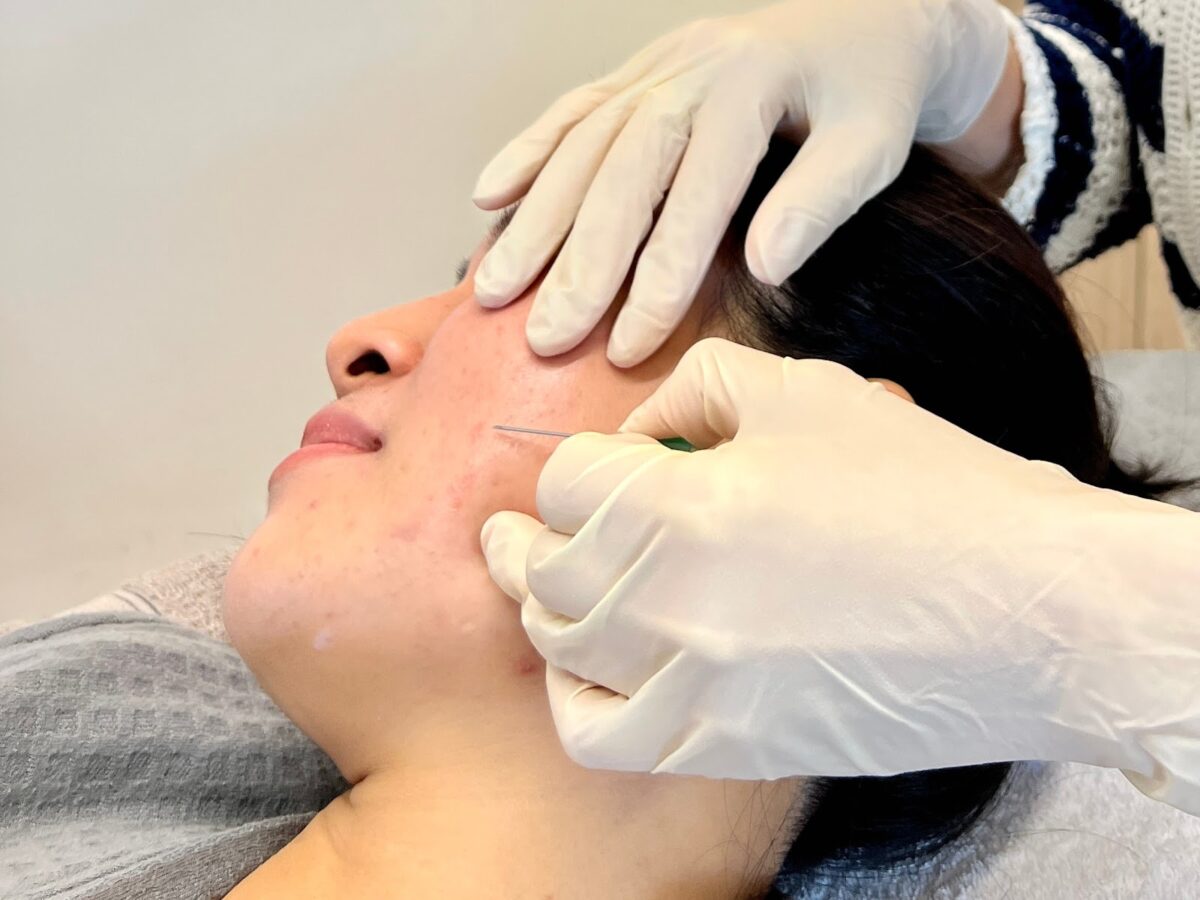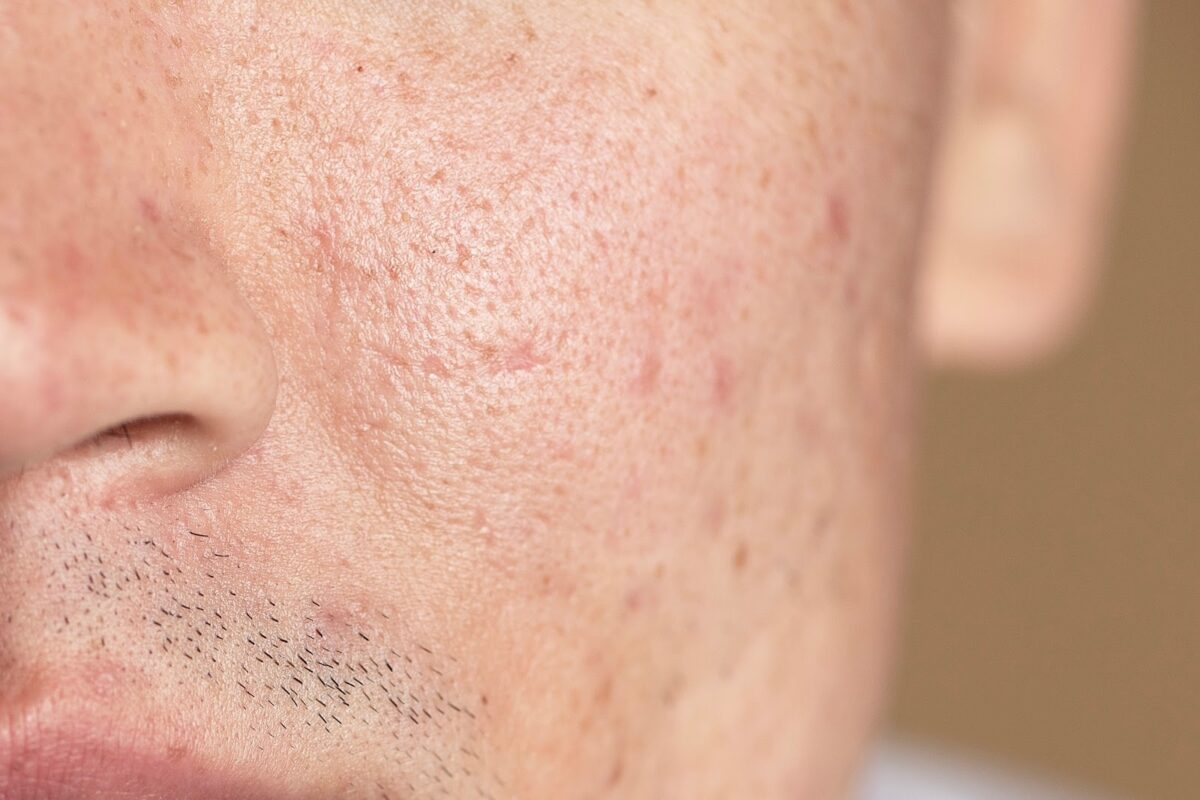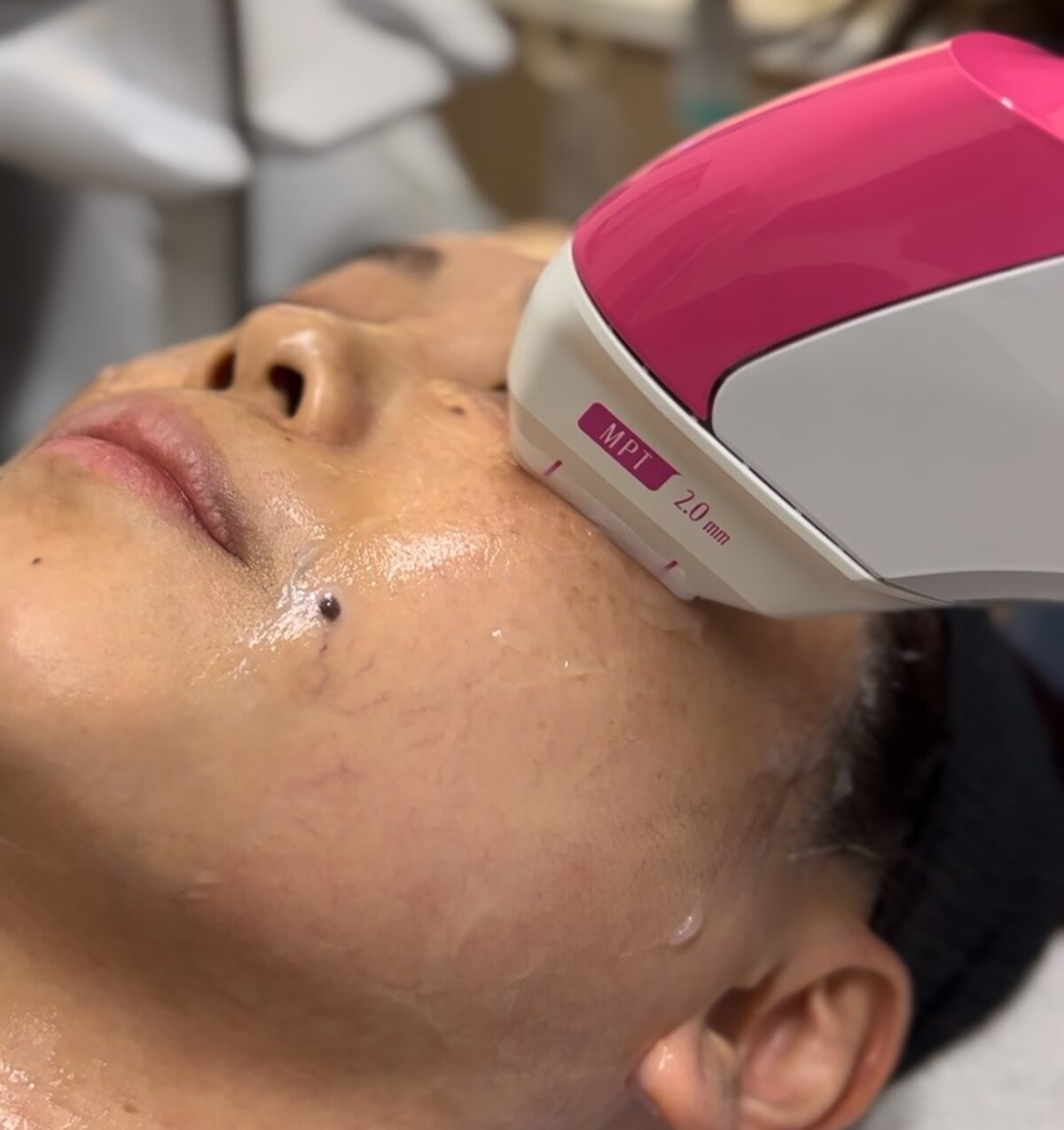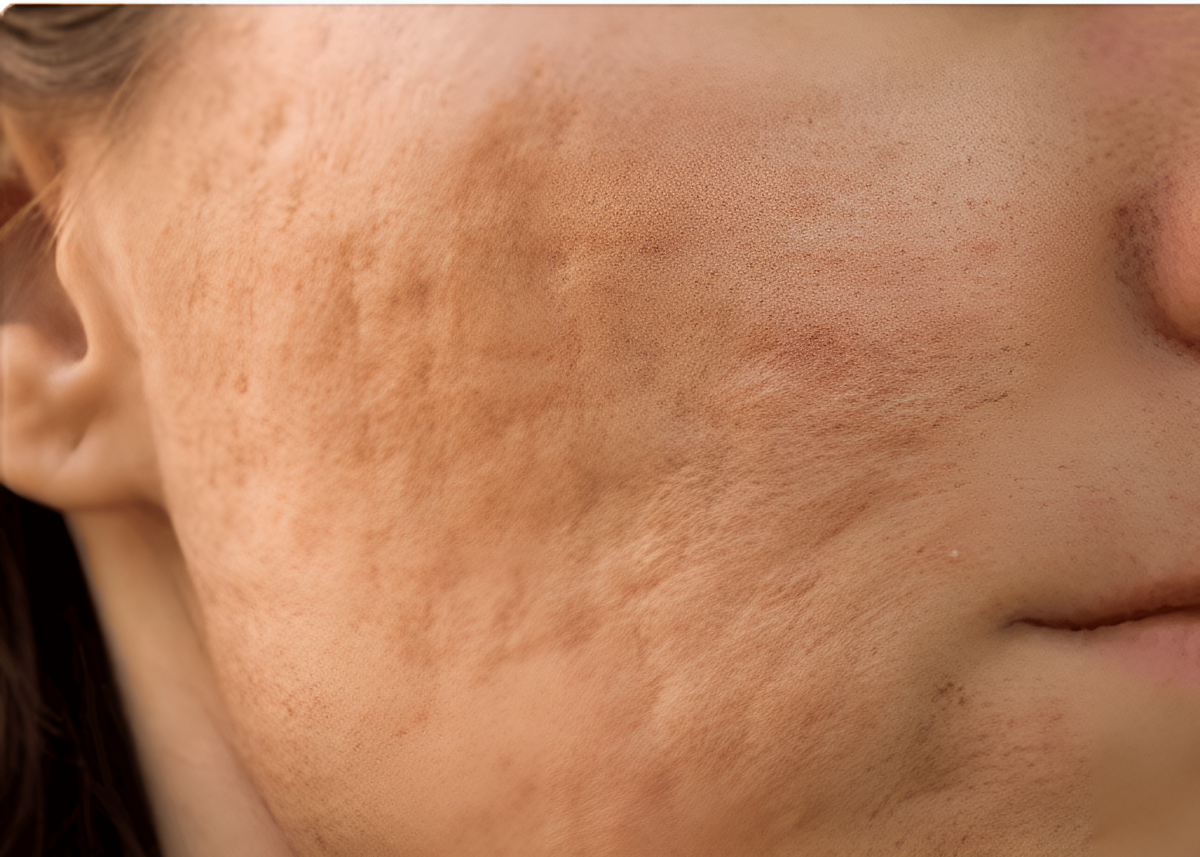Boxcar Scars: What They Are, Causes and Treatment Options
Are you looking for a way to make those boxcar scars less noticeable? Understanding the nature of these scars, their underlying causes and the treatment options available can help reduce their appearance. This article aims to provide comprehensive information on this skin condition and guide you towards suitable treatments.
What are Boxcar Scars?
A boxcar scar is an atrophic scar characterised by broad, shallow depressions with well-defined edges. Unlike other atrophic acne scars, boxcar scars are usually oval or round. This gives the skin a pitted or uneven texture. Boxcar scars can vary in depth, with some being quite shallow and others more pronounced.
What Causes Boxcar Acne Scars?
The causes of boxcar scars primarily revolve around skin trauma and inflammatory conditions. Severe acne is the most common cause, particularly nodular or cystic acne.
How do boxcar scars form? When the skin is damaged, it typically produces collagen to aid skin repair. However, in the case of acne, the intense inflammatory response can cause the breaking down of collagen fibres within the dermis. As the skin heals, inadequate collagen production forms depressed areas on the skin’s surface.
Conditions like chickenpox and other skin damage can also contribute to how boxcar scars form, as they involve similar inflammatory processes that disrupt the skin’s structure.
Boxcar Scars vs. Other Acne Scars
Boxcar scars differ from other types of acne scars, like ice pick scars and rolling scars, in their appearance and formation. Here’s an overview of the differences between these types of scars.
| Type of Scar | Appearance | Description |
| Boxcar Scars | Broad, shallow depressions with well-defined edges | Boxcar scars can be shallow or deep. Deeper variants extend into the reticular dermis – the inner layer with connective tissues that support the skin. |
| Ice Pick Scars | Deep, narrow pits that extend into the dermis | It can penetrate deeply into the dermis, sometimes reaching the hypodermis |
| Rolling Scars | Wavy structure with sloping edge | They are shallower than ice pick and boxcar scars and have sloped edges due to tethering of the dermis to the underlying tissue. |
Treatment Options for Boxcar Scars
Treating boxcar scars involves a variety of options, each with its benefits and considerations. Multiple treatments may be recommended together, as each option can complement the others, potentially enhancing skin texture and appearance.
Surgical Method

Surgical methods offer options for the treatment of boxcar scars. These approaches generally focus on removing or altering scar tissue to enhance skin texture and appearance.
Punch excision. This scar treatment involves excising the scarred tissue using a surgical punch. After the excision, the surrounding skin is stitched together. As the skin heals, new skin forms, creating a much smaller and less noticeable scar. This treatment can be used for deep boxcar scars.
Subcision. Subcision is a minimally invasive procedure with a small needle inserted into the skin beneath the scar. The needle cuts the fibrous bands that tether the scar to the underlying skin tissue, lifting the scar. The mechanism relies on the body’s natural healing process, as new collagen formation occurs during recovery, gradually reducing the scar’s appearance and skin texture.
Laser Therapy
Laser therapy utilises beams of laser energy to target specific layers of the skin, promoting skin renewal and collagen production.
- Ablative laser therapy. It works by removing the outer layers of the skin, which encourages the body to heal and regenerate new skin. One of the most widely known ablative laser therapies used in aesthetic procedures is fractional CO2 laser. The mechanism involves emission of short-pulsed light energy that penetrates the skin, removing layers of scarred tissue and promoting new skin growth.
Microneedling

Microneedling, also called collagen induction therapy, is a treatment that involves stamping with fine needles to create controlled micropunctures in the skin. This stimulates the body’s natural healing process, resulting in increased collagen production, which improves skin texture and reduces the visibility of atrophic scars. At Lux Medical, we use a Radiofrequency Microneedling device to help further improve acne scarring. The microneedles give off radiofrequency at its tips to further stimulate collagen growth and help smoothen acne scars.
Chemical Peel
Chemical peels accelerate skin renewal by using chemical agents to remove damaged outer layers of skin. This triggers the body’s natural healing process, increasing collagen production. As new skin cells form, they can help fill in depressions caused by acne scars to reduce their visibility.
The common peeling agents are TCA , glycolic acid,. Different peeling agents come in different concentrations and are used depending on the penetration depth.
Dermal Fillers
Dermal fillers plump the skin from underneath, filling in the depressions caused by acne scars. When injected into the boxcar scars, fillers help to elevate the indented areas. Most fillers can provide quick and noticeable improvements in the appearance of boxcar scars.
The most commonly used fillers for this purpose include:
- Hyaluronic acid fillers. It provides immediate volume and can stimulate collagen production over time.
- Poly-L-lactic acid fillers. It works by stimulating collagen production to plump the skin gradually and reduce the appearance of scars.
How To Prevent Boxcar Acne Scars
Preventing boxcars and other acne scarring starts with early intervention, a proper skincare routine and proactive treatment strategies. With the right approach, it is possible to reduce breakouts, inflammation and reduce the risk of scarring.
1. Treat acne promptly
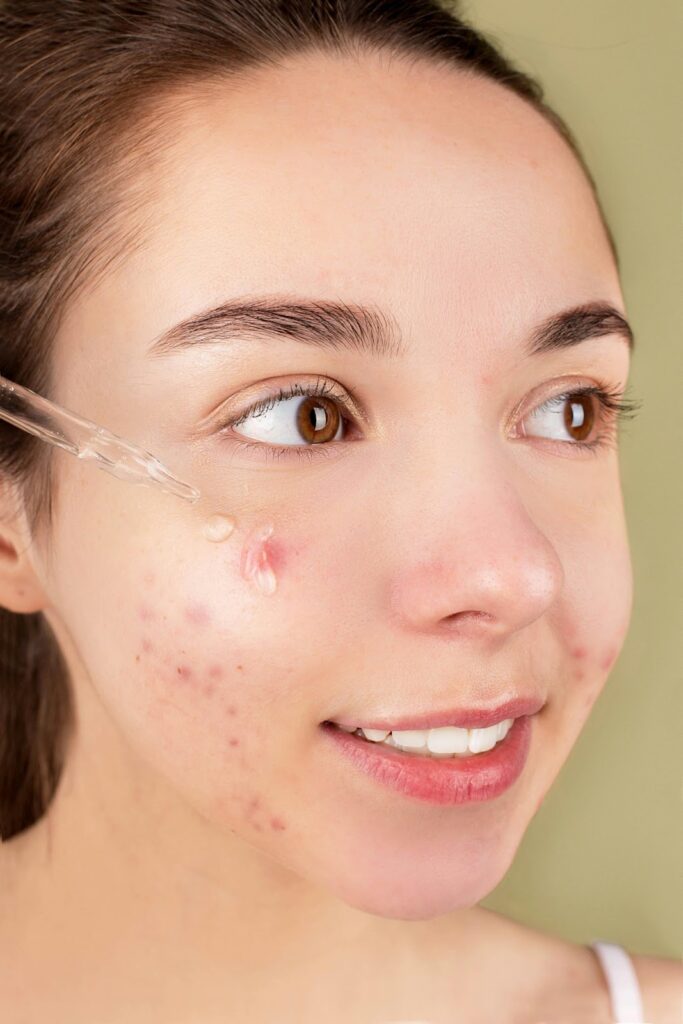
Addressing acne in its early stages is crucial to preventing long-term skin issues, including scarring. Timely treatment can help reduce inflammation and control breakouts.
Products containing benzoyl peroxide, salicylic acid, or retinoids can be effective for mild acne. However, it is essential to consult a skincare professional who can recommend appropriate treatments, including prescription medications or specialised therapies for more severe cases.
At Lux Aesthetic Clinic, we are dedicated to helping you manage acne and reduce the likelihood of scar formation. Schedule a consultation to start with a personalised journey towards clearer skin. – can be promotional since this is a blog
2. Opt for a gentle skincare routine
Look for cleansers, moisturisers and treatments without harsh chemicals, fragrances and alcohol, as these can exacerbate inflammation or disrupt the skin’s natural barrier. In addition, using non-comedogenic products designed not to clog pores can help prevent acne formation.
3. Hands off your face
Avoid picking or squeezing pimples, as it can worsen inflammation and increase the likelihood of scar formation. Touching your face can also cause the spread of bacteria and can irritate inflamed skin.
4. Use sun protection
Ultraviolet (UV) rays can delay the healing process by triggering inflammation, worsening scarring and existing acne. To minimise these effects, apply sunscreen consistently. Use a broad-spectrum oil free sunscreen with SPF 30 or higher and apply it repeatedly throughout the day.
5. Healthy lifestyle
A balanced diet of antioxidants and vitamins A, E and zinc can help prevent acne and support skin health. Staying hydrated helps maintain skin elasticity, while adequate sleep and stress management may help prevent acne breakouts.
Cost of Boxcar Treatment in Singapore
The cost of treating boxcar scars depends on various factors, like the type of treatment, the severity of the scars and the expertise of aesthetic professionals. Additionally, patients should consider the potential need for multiple sessions, which can impact overall costs.
We recommend scheduling a consultation with licensed dermatologists or aesthetic doctors to obtain detailed pricing estimates tailored to your needs and treatment plans.
Are boxcar scars permanent?
Boxcar scars are generally permanent, but their appearance can be reduced with various atrophic scar treatments. Consistent and targeted treatment can reduce the visibility of these scars over time.
Can boxcar scars be completely removed?
Removing boxcar scars completely is often challenging, especially for old and deep scars. While treatments can help manage their appearance, achieving a flawless, scar-free result is unlikely.
Treatment outcomes can include an improved skin texture and less noticeable scarring. It also depends on several factors, including the severity of the scars, the individual’s skin type and the chosen treatment method.
How long does it take to see results from treatments?
Improvements from treatment can vary depending on the treatment method and the severity of the scars.
- Immediate results. The results from dermal fillers are immediate, but they are temporary. They typically last from several months to a year, depending on the type of filler used.
- Gradual improvement. Laser therapy, Radiofrequency microneedling and chemical peels can help manage the appearance of scars over several weeks or months. Multiple sessions are often required.
Following the recommended treatment plan and aftercare instructions is essential for the best outcome. Treatment outcomes may also vary from person to person. Consult an aesthetic doctor to determine which treatment plan suits your specific concerns.
Conclusion
Boxcar scars can be a challenging skin concern. But with a clear understanding of their causes and available treatment options, you can make informed decisions to minimise their appearance and enhance overall skin health. While complete scar removal may not always be possible, various methods can achieve improvements.
Rolling Scars: What They Are, Causes, Treatment Options & 5 Tips
Everyone wants clear and smooth skin. The reality is it can sometimes be hard to achieve without some intervention, especially for people experiencing acne. There are scars acne can leave behind, and one of them is rolling scars. This atrophic scar is characterised by indents formed in the skin that give it a wavy, uneven texture.
If you’re looking for a treatment to reduce the appearance of rolling acne scars, then this blog is for you. Learn about this particular type of scar and get practical advice on managing and potentially reducing their appearance. You’ll also learn five essential tips for improving your skin texture and reducing the impact of these scars.
What Are Rolling Scars?
Rolling scars are a type of acne scar that appear as wave-like depressions on the skin. They are typically wider than other acne scarring and have a rounded, irregular shape. These scars form when fibrous bands of tissue develop between the skin and the underlying subcutaneous tissue, pulling the epidermis down and creating a rolling or undulating appearance.
Rolling acne scars are distinct from other types of depressed acne scars (atrophic scars), such as icepick and boxcar scars. Ice pick scars are narrow, deep and pitted, resembling the puncture marks made by an ice pick. On the other hand, boxcar scars are broad with well-defined edges, giving them a box-like appearance.
Rolling acne scars are more subtle and have a smoother edge, making them appear less severe but more widespread.
Causes of Rolling Scars
Rolling acne scars typically arise from significant acne outbreaks, especially from the more intense forms such as cystic acne. These acne scars form when severe inflammation disrupts the underlying collagen and elastin fibres, creating fibrous bands beneath the skin’s surface.
As the body heals from acne lesions, it attempts to regenerate damaged skin by producing new collagen fibres. However, this regeneration does not occur uniformly or adequately. Disproportionate or excessive collagen production can result in uneven skin texture and the development of rolling scars. The severity of these acne scarring often mirrors the initial intensity of the inflammation.
Beyond acne, there are other factors that may influence the likelihood of developing rolling scars. Mechanical factors like picking or squeezing blemishes can intensify inflammation and heighten the chance of scarring. Genetics also plays a pivotal role; individuals with a family history of rolling acne scars may have a higher predisposition to experience similar skin issues.
Treatment Options for Rolling Scars
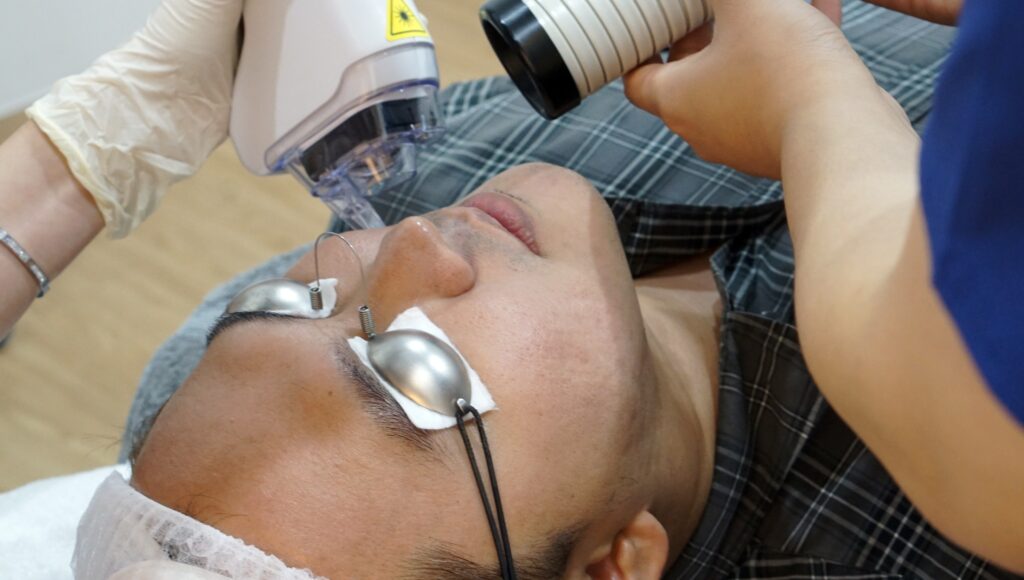
There are several treatment options for rolling scars, each with benefits and considerations. Here’s a closer look at some of the common methods for treating acne scars.
Laser Therapy
Laser therapy is a common treatment for rolling scars. It uses concentrated laser energy to remove layers of scarred skin, encouraging the growth of new, healthy skin. Different types of laser treatments are available, including ablative and non-ablative lasers.
Ablative lasers are more aggressive and remove the top layer of skin, while non-ablative lasers stimulate collagen production without damaging the surface. Only ablative lasers, such as fractional CO2 lasers, are effective for treating acne scars. Recovery times vary depending on the type of laser treatment used, but patients can generally expect to see improvements within a few sessions.
Radiofrequency Microneedling
Microneedling involves using a device with fine needles to create tiny, superficial punctures in the skin. This process stimulates the body’s natural healing response, promoting collagen and elastin production. Microneedling can be particularly effective for rolling scars as it targets the fibrous bands beneath the skin.
One variation, known as Intracel, combines microneedling with radiofrequency (RF) energy, delivering heat into the deeper layers of the skin to further stimulate collagen production and promote skin tightening — making it especially effective for atrophic scars like rolling and boxcar scars. The treatment can also be combined with other therapies, such as topical serums, to enhance results.
Recovery is usually quick, with most patients experiencing mild redness and swelling for a few days and improvements becoming more noticeable over the following weeks as collagen rebuilds.
Chemical Peels
Chemical peels involve applying a chemical solution to the skin, which causes the top layers to peel off, revealing smoother, unscarred skin underneath. There are different types of chemical peels, ranging from superficial to deep.
Superficial peels are gentle and require minimal downtime, while deeper peels offer more dramatic results but involve a longer recovery period. Chemical peels can help reduce the appearance of rolling acne scars by promoting the regeneration of healthy skin cells.
Dermal Fillers
Dermal fillers are injectable substances used to fill in depressed scars, smoothing out the skin’s surface. They can provide immediate results, making rolling acne scars less noticeable. Both temporary and long-term fillers are available.
Temporary fillers, like hyaluronic acid, last several months. Meanwhile, poly-L-lactic acid and other longer-term options can provide results that last up to two years. Dermal fillers are a good option for those looking for a quick fix with minimal downtime.
Subcision
Subcision is a minor surgical procedure where a needle is inserted under the skin to break up the fibrous bands causing the scar. This technique releases the tension, pulling the skin down and allowing it to lift and smooth out. Subcision is often combined with other treatments, such as microneedling or laser resurfacing. Recovery time is relatively short, with most patients experiencing bruising and swelling for a few days to a week.
5 Tips To Prevent Rolling Scars

Preventing rolling acne scars involves managing acne effectively and taking care of your skin. Here are five practical tips to help you in treating acne scars and keep your skin clear and scar-free.
Maintain a Consistent Skincare Routine
A daily skincare routine is crucial for preventing acne and minimising scarring. Start with a gentle cleanser to remove dirt and oil, followed by an exfoliator to unclog pores and remove dead skin cells. Finish with a moisturiser to keep your skin hydrated. Regular care can prevent acne from becoming severe enough to cause scarring.
Use the Right Skincare Products
Choosing the right skincare products can make a significant difference in preventing acne and scarring. Look for products containing ingredients like retinoids, salicylic acid and benzoyl peroxide, which are effective against acne. Salicylic acid helps to exfoliate the skin and unclog pores, and benzoyl peroxide kills acne-causing bacteria, and retinoids promote cell turnover. Be sure to select products suitable for your skin type to avoid irritation.
Follow a Healthy Diet
Diet plays a crucial role in skin health. Foods rich in antioxidants, omega-3 fatty acids and vitamins can promote clear skin and reduce inflammation. Incorporate fruits, vegetables, nuts and fish into your diet.
Avoid high-glycaemic foods, such as sugary snacks and refined carbohydrates, which can trigger acne breakouts. Maintaining a balanced diet can help keep your skin healthy and less prone to scarring.
Implement Lifestyle Changes to Prevent Acne
Lifestyle changes can also help prevent acne and, consequently, rolling scars. Reduce stress through relaxation techniques, such as meditation or yoga, as stress can worsen acne. Ensure you get enough sleep to allow your skin to repair itself.
Avoid habits that can exacerbate acne, like touching your face frequently or using dirty makeup brushes. Regular exercise and staying hydrated are also essential for maintaining clear skin.
Seek Professional Advice When Needed
If you have persistent or severe acne, it’s important to consult a professional. Our practitioners at Lux Aesthetic Clinic can provide treatment options to minimise the risk of acne scarring and offer recommendations on products and routines for your specific skin condition.
Cost of Rolling Scar Treatments in Singapore
Treating rolling acne scars varies in cost depending on the chosen method and the severity of the scars. Here’s a general pricing range for acne scar treatments in Singapore:
| Treatment | Average Cost Per Session |
|---|---|
| Laser Therapy | $200 – $1000 |
| Microneedling | $300 – $2000 |
| Chemical Peels | $150 – $600 |
| Dermal Fillers | $500 – $1500 |
| Subcision | $400 – $1000 |
Contact us to check if the treatment is available at our clinic and get a quote based on your needs.
Can Rolling Scars Heal on Their Own?
Unfortunately, rolling acne scars do not heal on their own. They result from a loss of collagen in the skin, leading to those wave-like depressions. While the appearance of these scars may become less noticeable over time, they won’t completely disappear without medical intervention. Medical treatments can reduce their visibility, improving the skin’s texture and appearance.
What Is the Best Age to Start Treating Rolling Scars?
Starting treatment for acne as early as possible is beneficial. The right age for acne scar treatment depends on the individual, but generally, once acne is under control, it’s advisable to begin scar treatment. Younger skin tends to heal faster and respond better to treatments, making early intervention essential. However, treatments are available for individuals of all ages.
How Long Does It Take to See Results from Rolling Scar Treatments?
The timeline can vary based on the treatment you have chosen, your skin type, and scar severity. Here’s an overview of the expected time frames:
- Laser therapy. Initial improvements can be seen within 1-3 months, with full results visible after several sessions.
- Microneedling. Noticeable changes typically occur within a few weeks, with continued improvements over several months.
- Chemical peels. Results can be seen after the skin has healed, usually within a few weeks.
- Dermal fillers. Immediate improvement is visible, with results lasting several months to years, depending on the type of filler.
- Subcision. Results are gradual, with improvements seen over several months as the skin heals and collagen production increases.
Is It Possible to Completely Remove Rolling Scars?
Complete removal of rolling scars is challenging, but significant improvement is achievable. Treatments can reduce the visibility of scars, smooth out the skin’s texture and improve overall appearance. Setting expectations and understanding that multiple acne scar treatments may be necessary can help you achieve optimal results.
Can I Combine Different Treatments for Better Results?
Combining treatments can enhance rolling scar therapy. For example, microneedling can be paired with PDRN or exosome serums, and subcision can be followed by laser therapy. Consulting with our practitioner can help you determine what combination of acne scar treatments suits your needs.
How Do I Choose the Right Treatment for My Rolling Scars?
Choosing the right acne scar treatment for rolling acne scars depends on several factors, such as the severity of the scars, your skin type and your personal preferences. It’s important to evaluate how deep and extensive the scars are, since deeper or more severe acne scars might require more intensive treatments like laser resurfacing or subcision. Chemical peels or microneedling could be sufficient for less severe scars.
Conclusion
Rolling scars can be a challenging skin concern, but understanding their causes and exploring the various treatment options can make a significant difference. You can prevent and treat rolling acne scars by maintaining a consistent skincare routine, using the right products, following a healthy diet, implementing lifestyle changes and seeking professional advice when needed.
If you’re ready to take the next step in your skincare journey, consider consulting with our skin specialist at Lux Aesthetic Clinic to develop a personalised treatment plan. With the right approach, achieving a more even skin texture is within reach.
Hypertrophic Scar: What Is It, Causes and Treatment Options
Scars are a natural part of the skin healing process, but not all scars heal the same. Hypertrophic scars, for example, can become overly prominent on the skin. If you’re facing issues with this type of scar, understanding what they are, their causes and the available treatment options can help you manage their appearance effectively. This post covers all the basics about this type of scar and offers practical treatment strategies to reduce its visibility.
What are Hypertrophic Scars?
Hypertrophic scars are raised, red and thickened areas of skin that form at the site of a wound. Unlike keloid scars, which can extend beyond the original wound, hypertrophic scars tend to stay within the boundaries of the injury. They are the result of an overproduction of collagen during the healing process.
Typically, these hypertrophic scars develop after burns, cuts, piercings or other skin injuries. Their appearance can vary, but they often appear red or purple and feel firm or rubbery. It’s worth noting that hypertrophic scars can fade and become less noticeable over time, although they rarely disappear without intervention.
Causes of Hypertrophic Scars
Understanding the causes of hypertrophic scars is crucial for prevention and effective management. These scars arise from the body’s excessive response to skin injury, involving several key factors that influence their development:
Depth and Severity of the Wound
Hypertrophic scars are more likely to develop when the wound is deep and severe. Deep wounds disrupt more skin tissue, and, as a result, the body’s healing process becomes more aggressive, leading to excessive collagen production, which forms a thick, raised scar. Surgical wounds, deep abrasions and injuries that reach into the dermis layer of the skin are typical examples that may evolve into hypertrophic scars.
Location of the Wound
The site of the injury significantly affects the likelihood of hypertrophic scarring. Areas of the body where the skin is naturally under more tension or is frequently moved, such as the shoulders, chest and joints like knees and elbows, are particularly prone to these types of hypertrophic scars. Skin tension interferes with healing, often leading to more pronounced scar formation.
Genetic Predisposition
Genetics play a critical role in how your skin heals. Some individuals are genetically predisposed to produce more fibrous tissue during healing, which can lead to more hypertrophic scars and keloids. If you have a family history of hypertrophic or other types of excessive scarring, such as keloids, you are at a higher risk of developing them as well.
Inadequate Wound Care
How a wound is cared for while it is healing can significantly impact the process and scar formation. Proper wound care involves keeping the wound clean, adequately dressed and moist. Poor wound care, leading to infection or prolonged healing times, can exacerbate the formation of hypertrophic scars. Bacteria can also increase inflammation, stimulating excessive collagen production as the body attempts to heal the wounded skin.
Infection During Healing
Infections can severely disrupt the normal healing process and lead to worse scarring. Bacteria and the resultant immune response increase the production of growth factors that stimulate fibroblast activity and collagen production, key components in hypertrophic scar formation.
Excessive Movement or Tension on the Wound
Mechanical stress on a healing wound is another significant factor that can lead to hypertrophic scarring. Suppose a wound is located in an area of the body that experiences frequent movement. In that case, the continual stress can cause the wound to reopen or become irritated, leading to more scar tissue as the body attempts to heal repeatedly.
How to Identify Hypertrophic Scars
Hypertrophic scars are notable for several key characteristics that can help their recognition and management. Here’s how you can identify them:
- Redness and raised texture. Hypertrophic scars are predominantly raised above the surface of the surrounding skin and typically exhibit a red or pink hue when they first form. This colouration can fade, but the raised nature remains a consistent feature. The texture of these scars is also distinctive; they can feel firm or rubbery to the touch.
- Firmness and thickness. The tissue of hypertrophic scars is denser and thicker than the normal skin around them. This firmness is due to the body’s excessive collagen deposits that heal the wound. The dense collagen makes these scars stiffer and can contribute to the discomfort or itchiness that some individuals experience.
- Size and shape. While hypertrophic scars are contained within the boundaries of the original injury, they can thicken and become more pronounced over time. They do not, however, extend beyond the original wound area, unlike keloid scars, which are characterised by their growth outside the initial boundaries of the wound.
- Change over time. Initially bright red or pink, hypertrophic scars may change colour as they mature, often paler than the surrounding skin. Despite these changes, the raised nature of the scar typically persists.
- Symptoms. It is common for hypertrophic scars to be itchy or uncomfortable, especially in the early stages of their development. Some individuals may also experience pain, particularly when the scar is in an area of frequent movement.
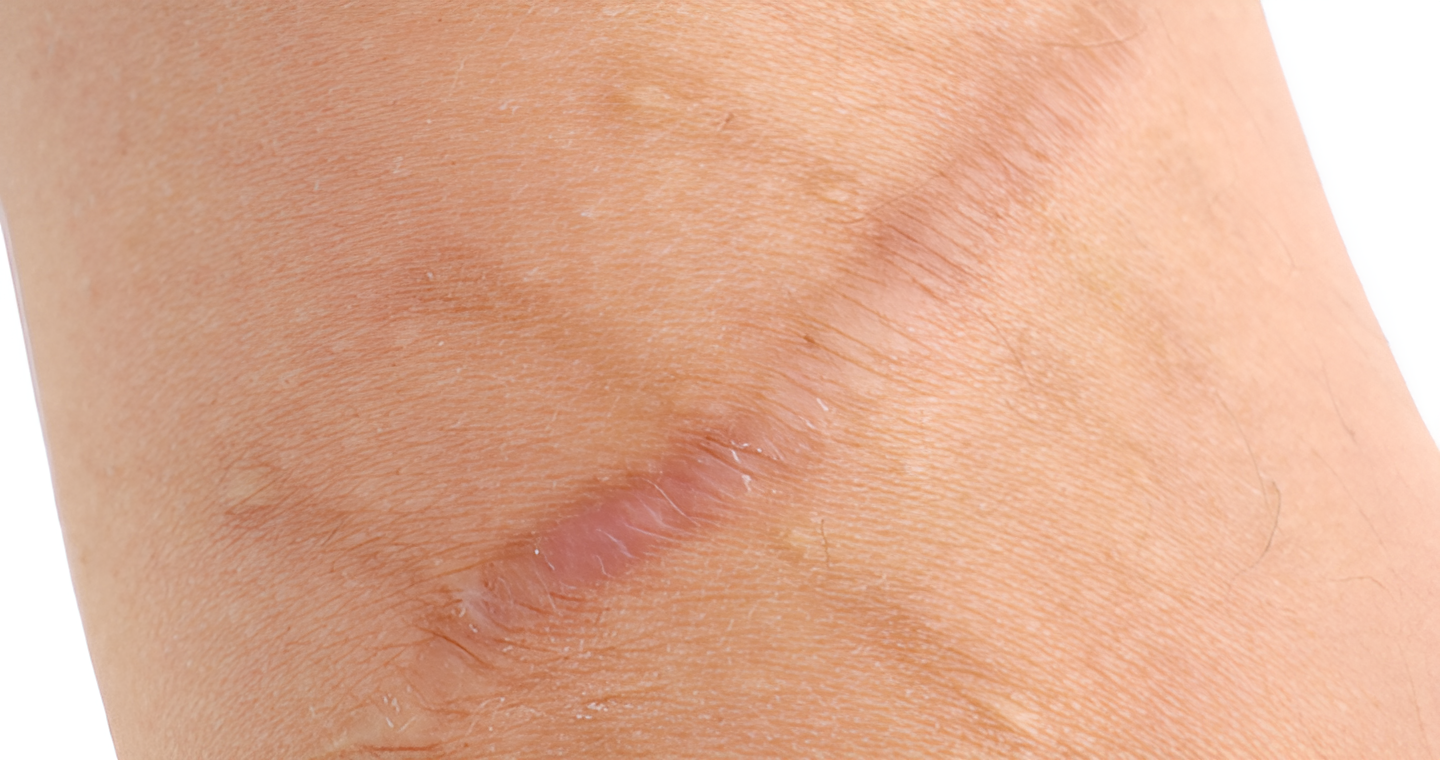
Treatment Options for Hypertrophic Scars
While hypertrophic scars can be persistent, various treatment options are available to manage and reduce their appearance. The choice of treatment depends on factors such as the scar’s size, age and location. Here’s a look at some popular treatments:
Corticosteroid Injections
Corticosteroid injections are a common treatment for hypertrophic scars. These injections help reduce inflammation and flatten the scar over time. Administered directly into the scar tissue, they decrease collagen production and soften the scar’s texture.
Typically, several injections are required over several weeks or months to achieve the desired results. While effective, it’s important to discuss potential side effects with a healthcare provider, as prolonged use can lead to skin thinning or discolouration.
Laser Therapy
Laser therapy is another option for treating hypertrophic scars. This treatment uses focused light beams to remove the outer layer of skin or stimulate collagen production beneath the surface. The specific type of laser used can vary depending on the scar’s characteristics.
Laser therapy can improve the texture and colour of hypertrophic scars, making them less noticeable. However, multiple sessions might be needed to see significant improvement.
Surgical Excision
In some cases, surgical excision might be considered for hypertrophic scars. This involves cutting out the scar tissue and closing the wound with sutures. While this method can effectively remove the hypertrophic scar, the new wound may develop into another hypertrophic scar. Surgical excision is often combined with other treatments like corticosteroid injections or silicone sheets to support optimal healing.
Six Prevention Tips for Hypertrophic Scars

Preventing hypertrophic scars is often easier than treating them. Here are six tips to treat hypertrophic scars and help reduce the likelihood of their formation:
1. Ensure proper wound care
Proper wound management is crucial for preventing hypertrophic scars. Begin by gently cleaning the wound with mild soap and water to remove debris and bacteria. This step minimises the risk of infection, which is crucial as it can complicate the healing process and increase the chances of severe scarring.
Once the wound is clean, apply an appropriate sterile dressing. The dressing acts as a barrier against bacteria and helps keep the wound environment moist, which is conducive to better healing.
Change the dressing as recommended to maintain cleanliness. Keeping the wound covered protects it from external irritants and reduces the chances of further injury, allowing the skin to heal smoothly and with minimal scar formation.
2. Apply silicone sheets or ointments
Silicone-based products are highly regarded for their effectiveness in scar management, particularly in preventing and treating hypertrophic scars. Silicone sheets or ointments cover the wound or scar, providing a protective layer that helps retain moisture and regulate collagen production. This environment discourages the excessive collagen buildup typical of hypertrophic scars.
For best results, consistently apply silicone sheets or ointments to the healed wound. This continuous application can significantly reduce the risk of developing thick, raised scars, promoting a flatter and less noticeable appearance.
3. Minimise tension on the wound
Physical stress on a healing wound is key to developing hypertrophic scars. To prevent this, avoid activities that might stretch or strain the wound area. Excessive movement can pull apart new tissue, causing the wound to heal with increased scar tissue.
Use support bandages or garments to immobilise and protect the area, especially if the wound is in a high-movement region, such as joints or areas prone to stretching. Maintaining the natural tension balance of the skin helps ensure that the healing process progresses without additional stress, reducing the potential for hypertrophic scarring.
4. Keep the scar moisturised
Maintaining hydration in the scar and surrounding skin is crucial for promoting healing and flexibility in the skin tissues. Regularly applying hydrating creams or oils keeps the scar and surrounding area supple, reducing the risk of the scar becoming rigid and raised.
Choose moisturisers appropriate for wound care – typically non-comedogenic and free from irritants. Keeping the scar moisturised helps with the skin’s elasticity and alleviates itching and discomfort that can accompany wound healing.
5. Treat inflammation early
Inflammation can make scar formation worse, making early intervention critical. If you notice signs of redness, swelling, or warmth, these indicate inflammation that could lead to excessive scarring. Treat these symptoms promptly with over-the-counter anti-inflammatory creams, or consult your doctor for more specific treatments.
Additionally, manage any underlying skin conditions, such as dermatitis, which can contribute to the problem. Early medical intervention can prevent these conditions from worsening the scar’s appearance.
6. Protect from sun exposure
Sun exposure can darken scars and make them more prominent and noticeable. Applying a broad-spectrum sunscreen with a high SPF or covering the scarred area with clothing or a bandage when outdoors helps protect it from harmful UV rays.
Consistent sun protection prevents darkening and supports the natural fading process, keeping the scar less noticeable over time. This is especially important during the first year of the wound healing process, as the scar tissue is still maturing and more susceptible to changes caused by UV radiation.
How long do hypertrophic scars take to heal?
Healing times for hypertrophic scars can vary significantly. Some scars may begin to flatten and fade within months, while others might take several years. The scar’s size, depth, location and individual skin characteristics influence the healing timeline.
While hypertrophic scars may never completely disappear, they often become less noticeable with time and appropriate treatment. Consistency in following recommended care routines and treatment plans can expedite the healing process and improve outcomes.
Can hypertrophic scars disappear on their own?
Hypertrophic scars have the potential to improve over time, but they rarely disappear completely without intervention. The body’s natural healing process can lead to a gradual reduction in size and elevation, making the scar less prominent.
However, achieving optimal results often requires proactive treatment. Consulting with a healthcare professional to discuss potential treatment options ensures you can effectively make informed decisions about managing your scars.
Are hypertrophic scars painful?
Hypertrophic scars can sometimes be associated with discomfort, such as pain or itching. The raised, firm texture of the scar tissue can lead to irritation, especially if the scar is located in an area prone to movement or friction.
If you experience persistent pain or itching, seeking medical advice is important. A healthcare professional can assess the scar and recommend suitable treatments to alleviate discomfort and improve the overall appearance.
What are the differences between hypertrophic scars and keloid scars?
Hypertrophic and keloid scars are both raised scars, but have distinct characteristics. Hypertrophic scars remain within the boundaries of the original wound, whereas a keloid scar or scars can extend beyond it, invading surrounding tissue.
Keloid scars tend to be more aggressive and can grow over time, even after the wound has healed. In contrast, hypertrophic scars are less likely to grow and may gradually flatten. Treatment approaches for these two types of scars can differ, so accurate diagnosis is crucial for effective management.
Can hypertrophic scars return after treatment?
While effective treatments can significantly reduce the appearance of hypertrophic scars, there is a possibility of recurrence. This is particularly true if the underlying causes, such as tension or inadequate wound care, are not addressed.
To minimise the various risk factors of recurrence, following recommended prevention tips and maintaining consistent scar care is important. Regular check-ins with a healthcare professional can help monitor the scar’s progress and make necessary adjustments to the treatment plan.
Conclusion
Managing hypertrophic scars involves a combination of preventive care and active treatment. By understanding the causes and exploring available treatment options, you can effectively control the appearance of these scars. Remember, consulting with a doctor can provide you with tailored advice and treatment plans suited to your needs.
Ice Pick Scars: What Is It, Causes and Treatment
Ice pick scars result from severe acne damaging the underlying skin tissue. Although they are difficult to treat, various methods can help reduce their appearance.
This article aims to provide essential information on the causes, characteristics and treatment options for this particular acne scar. Whether you’re looking to prevent these scars from forming or seeking ways to make them less noticeable, you’ll find comprehensive insights within these pages. With the right information and approach, you can take steps towards healthier skin.
What are Ice Pick Acne Scars?
Ice pick scars are characterised by a narrow, deep and pitted appearance resembling puncture marks. These are among the most challenging scars to treat and are a common form of atrophic acne scar. They form when a severe acne lesion damages the skin, extending deep into the dermis. The inflammation from the acne lesions causes tissue damage, creating a narrow, deep indentation.
Causes of Ice Pick Scars
The primary cause of ice pick scars is severe inflammatory acne, particularly cystic acne. These severe acne breakouts cause inflammation that extends deep into the skin’s inner layers, damaging the tissue. This damage destroys collagen, a protein that provides the skin structure and support, resulting in deep, narrow scars. While the body attempts to repair the damaged skin by producing collagen, it sometimes fails to produce enough to fill the depression, forming ice pick scars.
Picking or squeezing acne lesions can worsen inflammation and further damage the skin, increasing the likelihood of acne scarring.
How Ice Pick Scars Differ from Other Acne Scars
Ice pick scars differ from other acne scars in appearance and treatment challenges. Boxcar scars are broad and shallow with well-defined edges, while rolling scars have a wave-like appearance with a smoother surface.
In contrast, ice pick scars are deep, narrow indentations resembling small holes or puncture wounds. The severity and texture of ice pick scars often make them difficult to treat, as they penetrate deeper into the dermis than superficial scars.
Understanding these differences is crucial for selecting appropriate ice pick scar treatment options, as each type of scar may respond differently to various interventions.
Ice Pick Scar Treatment Options
Due to their depth and unique structure, ice pick scars are challenging to treat and often require professional intervention. Various treatments offer different benefits and work uniquely to improve scar appearance.
Chemical Peel
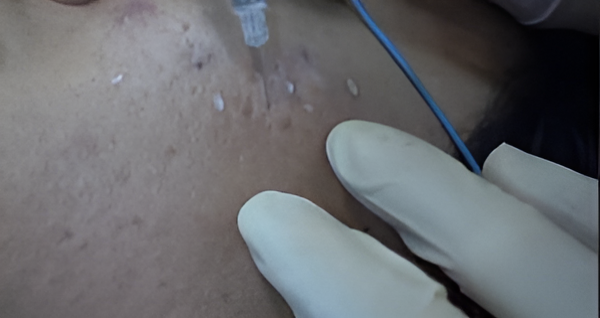
Chemical peel uses acidic solutions to remove the top layers of skin, promoting the growth of new skin. By exfoliating the outermost layer, chemical peels can help reduce the depth of ice pick scars. Trichloroacetic acid (TCA) chemical peel, particularly the CROSS technique, is used for treating ice pick acne scars.
This method involves the application of high concentrations of TCA directly in the scar. This localised treatment helps reorganise the dermal structure, encouraging new collagen formation and elevating the indented scar.
Radiofrequency Microneedling
Radiofrequency Microneedling is a minimally invasive cosmetic procedure that utilises fine needles stamped onto the skin to create small punctures. While in the skin, these fine needles produce radio frequency to aid in collagen production. These controlled micro-injuries, together with radio frequency, stimulate the body’s natural healing process, promoting collagen production and skin regeneration. As new collagen forms, it helps fill the deep indentations, gradually making their appearance less noticeable.
Laser Therapy
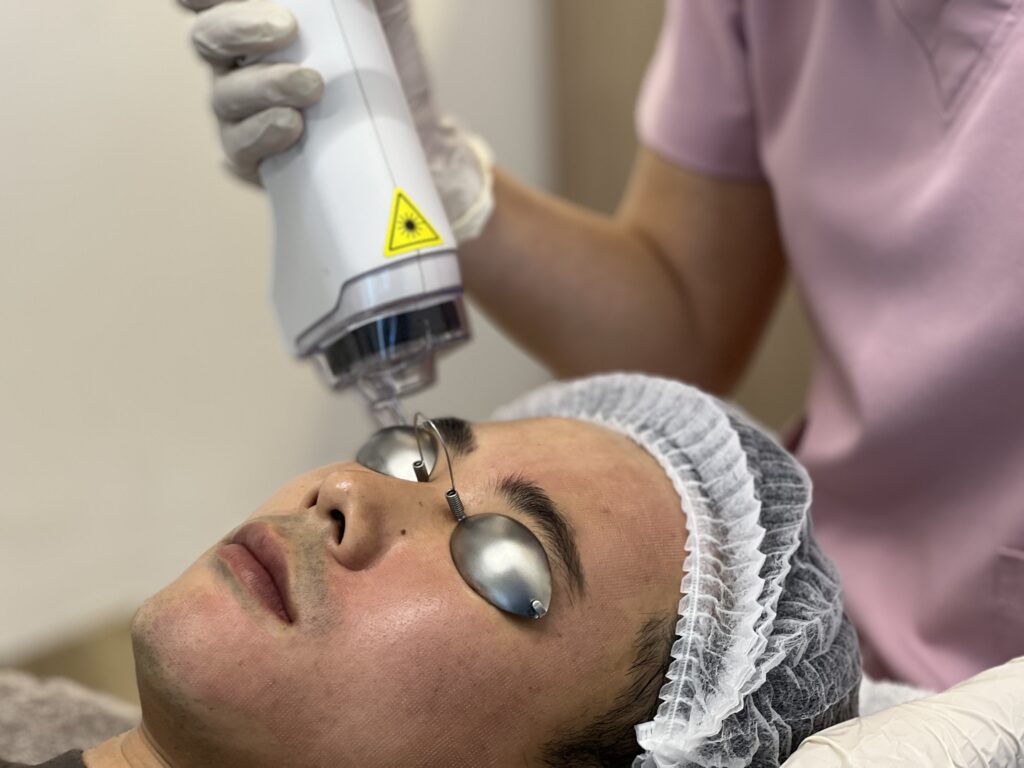
Laser treatments, such as Fractional CO2 lasers, target the skin’s deeper layers to promote collagen production and skin renewal.
Fractional CO2 lasers create micro-columns of thermal damage in the skin, triggering the body’s healing response. Fractional CO2 lasers remove the outer layer of damaged skin, allowing new, healthier skin to replace it. Laser therapy can significantly reduce the depth and visibility of ice pick scars by stimulating collagen and elastin production.
Fillers
Dermal fillers containing hyaluronic acid can be used to elevate depressed scars. Injectable hyaluronic acid is the most common type used for this procedure. Fillers add volume to the scarred area, reducing the appearance of indentations.
Punch Technique
- Punch grafting. This technique involves the removal of the scar and replacing it with a skin graft from another area of the body, such as behind the ear. Punch grafting may be employed for sharply defined or deep ice pick scars.
- Punch excision. Punch excision uses a circular punch tool to remove the scar tissue, allowing the skin to heal with a linear scar that is generally less noticeable. This technique transforms narrow, deep scars into flat, linear scars that can be more easily treated with subsequent procedures like laser resurfacing.
- Punch elevation. The scar is cut out using a punch tool smaller than the original scar. This creates a smaller wound, and the base of the scar is eventually elevated, creating a smoother transition with the surrounding skin. This technique is particularly useful for shallow ice pick scars.
Why Should You Treat Ice Pick Acne Scars
Improve Skin Appearance
One of the primary reasons to treat ice pick scars is to improve overall skin appearance. Ice pick scars can create an uneven skin texture. Addressing these scars can help individuals achieve a more uniform complexion. Treatments such as microneedling, laser resurfacing and chemical peels target the underlying damage, aiming to reduce scar visibility and improve skin texture.
Achieve Even Skin Tone
Certain treatments can help even out skin tone, making scars less noticeable. Chemical peels and laser therapy, in particular, can address hyperpigmentation and discolouration associated with acne scars. By promoting the growth of new skin, these treatments can improve overall skin tone.
Preventing Further Damage
Untreated ice pick scars can become more pronounced over time, especially if underlying acne persists. Proactively treating these scars may improve your skin’s appearance and help reduce the risk of further skin damage and scarring.
Supports Long-Term Skin Health
Treatments like Radiofrequency microneedling and Fractional CO2 lasers, can support long-term skin health by stimulating collagen production. Increased collagen helps maintain the skin’s structure and elasticity, potentially reducing the likelihood of future scarring.
How To Prevent Ice Pick Scars
1. Treat acne promptly and consistently.
Addressing acne breakouts promptly reduces the chance of deep inflammation and scarring. Early treatment can prevent acne from progressing to a severe stage, leading to ice pick scars.
2. Resist the urge to pick, pop, or squeeze pimples.
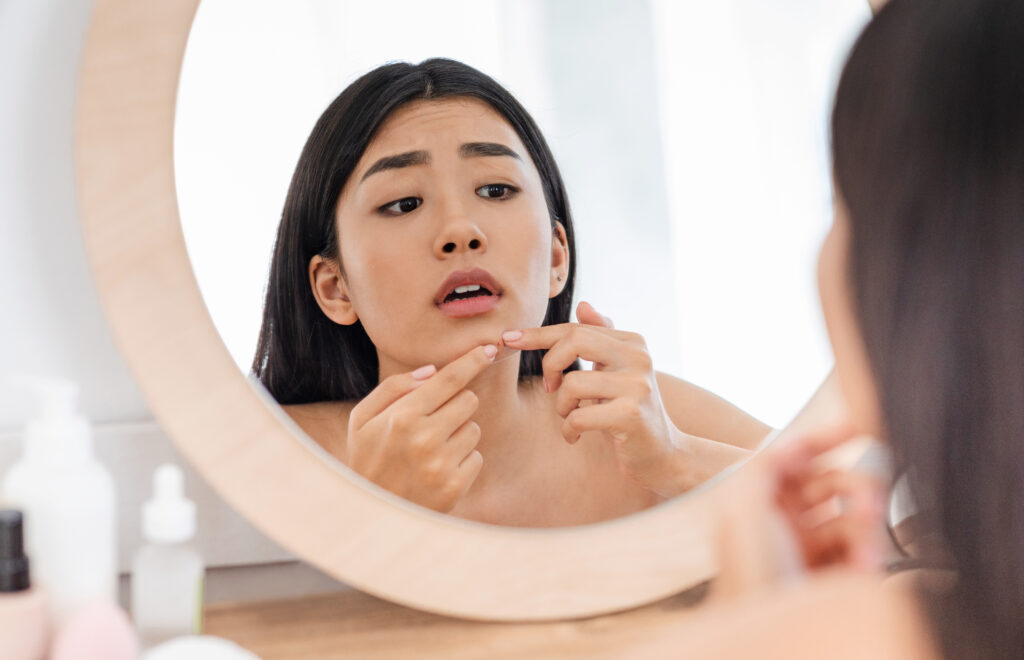
Picking or squeezing acne can worsen inflammation, leading to deeper skin damage and an increased risk of scarring. Instead, allow blemishes to heal naturally and consider using spot treatments to reduce their size.
3. Maintain a gentle skincare routine.
Establish a consistent skincare routine incorporating gentle cleansing, exfoliation and hydration to minimise the risk of acne breakouts. Using non-comedogenic products can further reduce the chance of clogged pores.
4. Avoid prolonged sun exposure.
Sun exposure can delay the healing process of acne and increase the risk of scarring. Applying broad-spectrum sunscreen can protect your skin from the sun’s harmful UV rays. This not only helps in preventing new scars but also preserves the results of any treatments received.
5. Consult with a professional.
Regular check-ins with an aesthetic doctor can help monitor your skin’s health and detect potential issues early. They can recommend personalised skincare regimens and treatment options that align with your skin concerns, significantly lowering the risk of developing ice pick scars.
Can ice-pick acne scars heal on their own?
Ice pick scars rarely heal on their own. The deep nature of these scars often requires professional treatments to see noticeable changes.
Are ice-pick acne scars permanent?
Ice pick scars are generally permanent due to their deep and narrow nature, which makes them resistant to natural healing processes. However, various acne scar treatments can reduce their appearance, making them less noticeable.
How long does it take to see results from ice pick acne scar treatments?
Results vary depending on the treatment type, individual skin types and the severity of the scars. It may take several weeks to months to notice changes, and some treatments require multiple sessions.
Can home remedies be effective for ice-pick acne scars?
Home remedies might not provide the same level of effectiveness as professional dermatological treatments, but they may offer some benefits in improving skin texture and promoting healing. Selecting appropriate remedies that align with your skin type and conditions is also important to help reduce the risk of skin irritations.
What are the potential side effects of ice pick acne scar treatments?
Potential side effects from treatments for ice pick scars may vary depending on the procedure used. Common side effects include discomfort, redness, post-inflammatory hyperpigmentation, swelling and temporary skin sensitivity in the treated area.
Is it possible to get rid of ice pick acne scars after treatment?
While eliminating ice pick scars may not always be achievable, scar reduction can be achieved following appropriate treatment. Patient adherence to treatment regimens and aftercare advice is crucial for promoting better outcomes, as this consistency supports the healing process.
How much do treatments for ice pick acne scars cost in Singapore?
The cost can vary depending on the type of treatment, the extent of the scarring and the frequency of the chosen treatment. TCA CROSS treatment typically starts from $250*. Our doctor will work with you to determine the best treatment options and create a personalised care plan.
Can diet and lifestyle changes help prevent ice pick acne scars?
Diet and lifestyle changes can help improve skin health and reduce the risk of severe acne and scarring. Maintaining a balanced diet and proper hydration supports skin health. Reducing stress, getting adequate sleep and following a consistent skincare routine can also help prevent acne breakouts.
How do I choose the right treatment for my ice pick acne scar?
Choosing the right treatment for ice pick acne scars involves consulting with a qualified professional who can evaluate your skin type, scar severity and overall skin health. They can recommend tailored treatments based on your needs, helping you make an informed choice.
Can ice-pick acne scars recur after treatment?
While treated scars typically do not recur, new acne breakouts can cause new scars if not properly managed. Maintaining good skin care practices and addressing acne can help prevent future acne scarring.
Conclusion
Ice pick scars can be stubborn, but with the right treatment, improvements are possible. Understanding the different acne treatment options and consulting with an aesthetic doctor can help improve your skin’s appearance. Remember, prevention is important, so practising good skincare habits and seeking early treatment for acne can help reduce the likelihood of developing ice pick scars.
Keloid Scar: What Is It, Causes, Symptoms and Treatment Options
One of the most challenging scars to remove are keloid scars. These raised, often itchy scars can grow beyond the original wound, making people who have them self-conscious.
Understanding their causes, symptoms, and various treatment options can help reduce their appearance.
What is a Keloid Scar?
A keloid scar is a raised scar that occurs due to the overgrowth of scar tissue at a healed skin injury. Unlike normal scars, keloid scars extend beyond the original wound and can grow over time.
They are characterised by their thick, raised appearance and are typically more pronounced than hypertrophic scars.
What Does a Keloid Scar Look Like?
As mentioned above, keloid scars appear to be raised, smooth, and shiny on the skin. Depending on the person’s skin colour, they can vary from pink to red or even dark brown. They often feel firm to the touch and sometimes tender, itchy, or even painful.
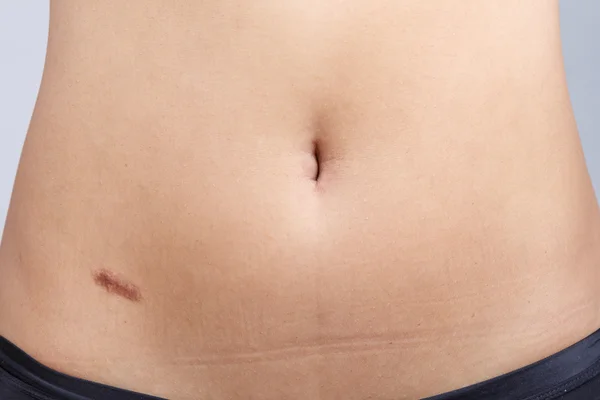
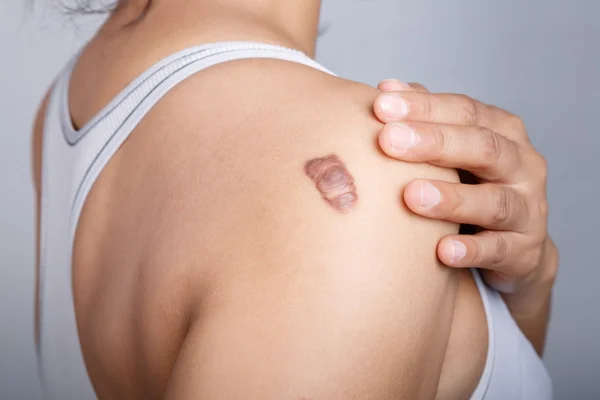

Where are Keloid Scars Commonly Found?
Keloid scars can grow anywhere on the body where there has been skin injury, but they are most commonly found in the following areas:
- Chest. Particularly common after the occurrence of acne scars or surgical procedures.
- Shoulders and upper arms. It often results from skin injuries or vaccinations.
- Ears. It is frequently seen after ear piercing, especially on the earlobes.
- Neck. It can develop from cuts, surgical incisions or acne scars.
- Back. Typically, they form after an acne breakout or from surgical incisions.
Causes of Keloid Scars
Keloid scarring occurs due to an overproduction of collagen during the wound-healing process. Different factors can increase the risk of developing keloid scar, including:
- Genetic component. A strong genetic predisposition can make some people more likely to develop keloids.
- Skin colour. Individuals with darker skin tones, such as brown or black skin, are more prone to keloid formation.
- Type of skin injury. Keloids can form after acne scars, surgical incisions, piercings, cuts, burns and even insect bites.
- Location of injury. Areas like the chest, shoulders and earlobes are more susceptible to keloid scars.
- Age. Younger individuals, especially those in their teens to early twenties, are more likely to develop keloids.
Early Signs and Symptoms of Keloid Scars
The early signs and symptoms of keloid scars include:
- Pain. You may feel pain in the affected area, especially as the keloid grows.
- Itching. Itchiness is a common early symptom, often indicating the start of keloid formation.
- Tenderness. The scar tissue can feel tender to the touch.
Treatment Options for Keloid Scars
Keloid scar removal can be challenging, but various treatment options are available to help reduce their size and appearance.
Corticosteroid Injections
Corticosteroid injections are one of the most common treatments for keloid scars. They work by reducing inflammation and slowing down collagen production, which helps to flatten the scar tissue.
Typically, multiple injections over several months are required for optimal results.
Laser Therapy
Laser therapy uses concentrated light beams to reduce the appearance of keloid scars. The laser treatment damages and shrinks the scar tissue’s blood vessels. Laser therapy can be particularly effective when combined with other treatments like corticosteroid injections.
Surgical Excision
Surgical excision involves cutting out the keloid scar. While this method can effectively remove the keloid, there is a high risk of recurrence, often in larger scars.
Combining surgery with other treatments like corticosteroid injections or radiation therapy can reduce the risk of the keloid returning.
Topical Treatments
Topical keloid scar treatments like silicone gel pads can help flatten and soften the scars. These products create a barrier that reduces collagen production, helping to improve the scar’s appearance over time.
They are often used in conjunction with other treatments for improved outcomes. They can also help ease itching as the wound heals.
How To Prevent Keloid Scars?
Avoid skin injuries
While we can’t avoid cuts and scrapes entirely, minimising skin injuries can help prevent keloid scars. Wearing protective gear during sports or activities that could result in cuts or abrasions can reduce the risk of developing keloids.
Conduct proper wound care
Proper wound care is important in preventing keloid scarring. Keeping wounds clean and covered promotes healthy wound healing and reduces the likelihood of excessive scar tissue formation. Basic wound care tips include:
- Clean the wound with mild soap and water immediately after a cut or abrasion.
- Apply an antiseptic to the affected area.
- Cover the wound with a sterile bandage to keep it moist and protect it from microbes.
Use silicone sheets or gel
Silicone sheets or gel prevent keloid scars by protecting the wound. These products help hydrate the skin and reduce excessive collagen production, which can minimise scar formation.
To use silicone gel sheets, apply them directly to the healed wound according to product instructions.
Protect the scar from sun exposure
Sun exposure can worsen scars by causing hyperpigmentation. That’s why protecting your scars from the sun by using any sunscreen and wearing protective clothing can help them heal more evenly. This is particularly important for fresh scars and those prone to keloid formation.
Monitor recent piercings
Recent piercings, especially ear piercings, can increase the risk of developing keloids. Regularly cleaning the piercing and avoiding trauma to the area can help prevent keloid formation.
Avoiding body piercings if you have a history of developing keloids is also advisable.
Consult with a professional
If you have a history of keloid scars or notice changes in your skin after an injury, consult with a professional immediately. Early treatment can help minimise the risk of keloid formation and ensure proper wound healing.
Are keloid scars dangerous?
Keloid scars are generally not dangerous to your overall health. However, they can cause discomfort, pain and itching. In some cases, large keloids can restrict movement, particularly if they are located near joints.
Can keloid scars recur after treatment?
Yes, keloid scars can recur after treatment. The rates of recurrence vary depending on the treatment methods used and individual factors. Combining treatments, such as surgical excision with corticosteroid injections, can reduce the likelihood of keloid scars recurring.
What is the difference between keloids and hypertrophic scars?
Keloid and hypertrophic scars are both raised scars, but have distinct differences. A keloid scar grows beyond the original wound boundary and can continue to enlarge over time.
In contrast, a hypertrophic scar remains confined to the original wound area and often flattens and sometimes fades over time. Hypertrophic scars are generally less challenging to treat than keloid scars.
Can keloid scars affect tattooed skin?
Tattooed skin is at risk of developing these scars, particularly in individuals prone to keloids. The trauma from the tattoo needle can trigger keloid formation. It’s essential to discuss this risk with a professional before getting a tattoo, especially if you have a history of keloids.
Can children get keloid scars?
Yes, children can develop keloid scars, particularly if they have a genetic predisposition. Parents should closely monitor any injuries or piercings and seek advice from a skin specialist if they notice any signs of keloid formation. Early treatment can help manage keloid scars in children effectively.
Conclusion
Keloid scars can be a significant concern for many individuals, but understanding their causes, symptoms, and different treatment options can help prevent and manage them effectively.
If you are concerned about keloid scars, consult a professional to explore the most suitable treatment options. Taking proactive steps to prevent keloids and seeking early treatment can improve skin health and well-being.
Chemical Peel Singapore – Address Sun Damage & Acne Scars

Many people in Singapore experience skin challenges, such as acne scars and sun damage, leading them to seek treatments to enhance their complexion. Chemical peels offer an option for those looking to improve their skin’s appearance.
Here, we will explore everything you need to know about chemical peels, from how the treatment process works to the different types available in Singapore. By the end, you will have enough knowledge to decide whether this treatment is right for you.
What is a Chemical Peel?
A chemical peel is a dermatological procedure involving the application of a chemical solution to the skin, promoting exfoliation and the removal of dead skin cells to reveal new skin underneath. The treatment can vary in depth, from superficial to deeper chemical peels, depending on the desired outcome and the skin condition being addressed.
Chemical peel treatments are available for various skin types and may address acne scars, sun damage, and uneven texture lines. These treatments aim to improve skin texture, making the skin appear and feel smoother. However, results can vary depending on individual skin types and conditions.
How Do Chemical Peels Work?
Chemical peels involve applying a solution to the skin that exfoliates the outer layer, removing dead skin cells and revealing fresh, new skin. This process enhances skin texture and appearance, with the depth of peeling varying based on the type of peel and individual skin characteristics.
Types of Acids Used:
- Salicylic Acid: An oil-soluble beta hydroxy acid (BHA) that penetrates oily skin and unclogs pores, making it highly effective for treating acne. It also has anti-inflammatory properties that help reduce redness and swelling.
- Glycolic Acid: An alpha hydroxy acid (AHA) derived from sugar cane, known for improving skin texture and tone. Its small molecular size allows it to penetrate deeply, enhancing collagen production and reducing fine lines and uneven skin tone.
- Lactic Acid: A milder AHA derived from milk, suitable for sensitive skin. It provides gentle exfoliation and hydration, making it ideal for those with delicate skin conditions.
Benefits of Chemical Peels
In Singapore, where the hot and humid tropical climate can exacerbate skin issues, chemical peels are a popular choice. Chemical peels offer various options to address skin concerns, making them a widely sought-after treatment in Singapore. Whether dealing with stubborn acne scars that refuse to fade or hoping to recover from years of sun exposure, chemical peels may be a suitable option for you.
Let’s explore the benefits of chemical peels.
Skin Rejuvenation
Chemical peels help remove the damaged outer layers of your skin, potentially revealing a new, healthier layer. This process may result in smoother, more luminous skin with improved texture and tone. However, results can vary depending on individual skin conditions and peel type.
Acne Treatment
Some types of chemical peel treatments may help to unclog pores, reduce inflammation, and promote the healing of acne scars, potentially leading to clearer skin over time.
Anti-Ageing Effects
Chemical peels may reduce the appearance of fine lines and wrinkles by stimulating collagen production. This may result in firmer and smoother skin, although outcomes can vary based on individual skin characteristics.
Who are the Ideal Candidates for Chemical Peels?
Chemical peels may be beneficial for individuals looking to address specific skin concerns. They are often recommended for those with:
- Acne-Prone Skin: Chemical peels can help to clear clogged pores and reduce acne by exfoliating dead skin cells and calming inflammation. They may also improve the appearance of acne scars.
- Uneven Skin Tone: If you have hyperpigmentation, dark spots, or uneven skin tone, chemical peels can help to exfoliate and promote a more balanced complexion.
- Fine Lines and Wrinkles: By stimulating the production of new skin cells and collagen, chemical peels can reduce the appearance of fine lines and wrinkles, leading to smoother and more youthful-looking skin.
- Sun-Damaged Skin: For those with sun-damaged skin, chemical peels can rejuvenate the skin by removing damaged outer layers and improving overall texture and tone.
Considerations for Certain Skin Conditions
For individuals with specific skin conditions, alternative treatments might be recommended:
- Rosacea: If you have rosacea, which causes redness and sensitivity, alternative treatments such as topical gels or lasers might be more suitable. Consulting with a skin specialist can help determine the best approach.
- Eczema: For those with eczema, which is a dry skin condition, a more gentle treatment may be suggested to prevent irritation.
- Sun Sensitivities: If your skin is particularly sensitive to sunlight, it’s important to discuss this with a specialist. They can provide guidance on how to proceed safely and ensure proper sun protection.
A thorough assessment by a skin specialist will help determine the safest and most appropriate treatment based on individual skin types and conditions.
Types of Chemical Peels Available in Singapore
There are three chemical peels in Singapore, each differing in depth. Here’s a quick comparison:
| Type | Depth | Typical Ingredients | Recovery Time |
|---|---|---|---|
| Superficial Peel | Light | Lactic acid, Salicylic acid | 1-7 days |
| Medium Peel | Medium | Glycolic acid, TCA (Trichloroacetic acid), Salicylic acid | 7-14 days |
| Deep Peel | Deep | Phenol, TCA (Trichloroacetic acid) | 7-14 days |
Superficial Peels
Superficial peels (light peel) target the top layer of the skin and are suitable for mild skin concerns.
Common Ingredients: Lactic acid, Salicylic acid
Ideal Candidates: Individuals with minor skin imperfections
Treatment and Recovery: The chemical solution is applied to the skin for a few minutes, with recovery typically occurring within a week, involving minimal downtime.
Medium Peels
Medium peels penetrate deeper into the skin, making them suitable for addressing more significant issues like wrinkles and pigmentation.
Common Ingredients: Glycolic acid, TCA (Trichloroacetic acid), Salicylic acid
Ideal Candidates: Individuals with more prominent skin concerns, such as wrinkles or pigmentation
Procedure and Recovery: This peel involves a stronger chemical solution that penetrates the middle layers of the skin.
Deep Peels
Deep chemical peels use potent acids, such as phenol, and are typically used for more advanced skin concerns.
Common Ingredients: Phenol, TCA (Trichloroacetic acid)
Ideal Candidates: Individuals with severe skin concerns, such as deep wrinkles or solar keratosis
Procedure and recovery: The procedure involves applying a strong chemical solution to reach deeper skin layers, with recovery potentially lasting several weeks and requiring careful post-treatment care
Chemical Peel Procedure
Here’s a general guide to what you can expect from a chemical peel procedure:
Pre-Treatment Consultation
Before undergoing a chemical peel, a thorough skin assessment is crucial to determine the most suitable type of peel for your skin concerns. This evaluation considers factors such as skin type, texture, and specific issues you aim to address, ensuring the treatment is tailored to your skincare needs.
The Treatment Process
Comfort is a key priority throughout the chemical peel procedure. The treatment unfolds in a series of carefully managed steps:
- Initial Cleansing:
- The process begins with a thorough cleansing of your skin to eliminate impurities, oils, and makeup. This step ensures that the chemical solution can penetrate the skin effectively.
- Application of Chemical Solution:
- A chemical solution tailored to your skin type and treatment goals is then applied. Depending on the specific acids used, you might experience a mild tingling or burning sensation, which is a normal part of the process.
- Monitoring and Adjustments:
- Throughout the procedure, the intensity of the peel is carefully monitored. The doctor will make adjustments as needed based on your skin’s reaction to ensure both safety and optimal results.
- Neutralisation and Soothing:
- Once the desired exfoliation is achieved, the chemical solution is neutralised and removed. A soothing treatment is applied to calm the skin and alleviate any redness or irritation.
Post-Treatment Care
You might experience some redness, peeling, or dryness following the procedure. Proper aftercare is essential for optimal results and the health of your newly revealed skin. After the procedure, you should:
- Moisturise Regularly: Apply a gentle, non-comedogenic moisturiser to keep the skin hydrated and aid healing.
- Use Broad-Spectrum Sunscreen: Protect the skin from UV rays with a broad-spectrum sunscreen of at least SPF 30, reapplying every two hours when exposed to sunlight.
- Avoid Direct Sun Exposure: Stay out of the sun during peak hours to prevent irritation and damage to the sensitive post-peel skin.
- Refrain from Using Harsh Skincare Products: Avoid products that contain strong acids, exfoliants, or retinoids, as they can irritate the skin during the healing phase.
- Hold Off on Makeup: Wait until the peeling process has completed and any redness or sensitivity has subsided before using makeup. Opt for mild, non-comedogenic products when you start applying makeup again.
- Stay Hydrated: Drinking plenty of water helps support the skin’s healing process from the inside.
Adhering to these steps will help you maximise the benefits of your chemical peel and maintain long-term skin health. Your skincare professional will provide detailed aftercare instructions to ensure proper recovery.
Chemical Peel Singapore Price
Chemical peel prices start at $250 and may increase depending on the type of peel (superficial, medium, or deep) and the number of sessions required.
FAQs (Frequently Asked Questions)
Atrophic Scars: What It Is, Causes, and Treatment
Atrophic scars are a common concern for many people who have experienced severe acne.
These pitted scars can affect self-esteem and overall skin health, making it important to address them effectively. Understanding their causes and the treatment options are essential for achieving healthier, smoother skin.
By exploring various treatments and preventive measures, you can take control of your skin’s appearance and restore your confidence. With the right approach, you can reduce the appearance of these scars and enjoy a revitalised complexion.
What are Atrophic Scars?
Atrophic scars, including ice pick scars, are indented scars that form below the upper layer of the skin due to a loss of collagen. Unlike hypertrophic scars, which are raised and form above the skin, atrophic scars result from insufficient collagen production during the healing process.
Atrophic scars can be categorised into three main types:
- Ice Pick Scars: Narrow, deep scars that extend into the dermis, resembling small holes.
- Boxcar Scars: Broad, rectangular depressions with sharp edges, often appearing on the temples and cheeks.
- Rolling Scars: Wide depressions with rounded, sloping edges, giving the skin a wave-like appearance. That is why they are called rolling scars.

Causes of Atrophic Scars
Atrophic scars primarily result from severe acne that damages the skin’s deeper layers. When acne lesions penetrate deeply, they damage the skin and the underlying tissue.
If the body produces insufficient collagen during healing, atrophic scars form. Improper acne treatment can exacerbate this issue, leading to more pronounced scarring.
Atrophic Scars Treatment Options
Depending on your skin type, there are various effective treatments or multiple procedures for atrophic scars, each targeting different aspects of scar improvement.
Laser Therapy, Fractional Co2
Fractional Co2 Laser, also known as laser resurfacing, uses focused light beams to remove damaged skin layers and stimulate collagen production. This promotes the growth of new, healthier skin cells, reducing the appearance of atrophic scars.
Microneedling, Intracel
Microneedling, also known as skin needling, involves creating tiny punctures in the skin with fine needles. This process encourages collagen and elastin production, which helps to smooth out scars and improve skin texture.
Chemical Peels
Chemical peels involve applying a chemical solution to the skin, which exfoliates the top layers and encourages new skin growth. This can help to reduce the depth and visibility of atrophic scars.
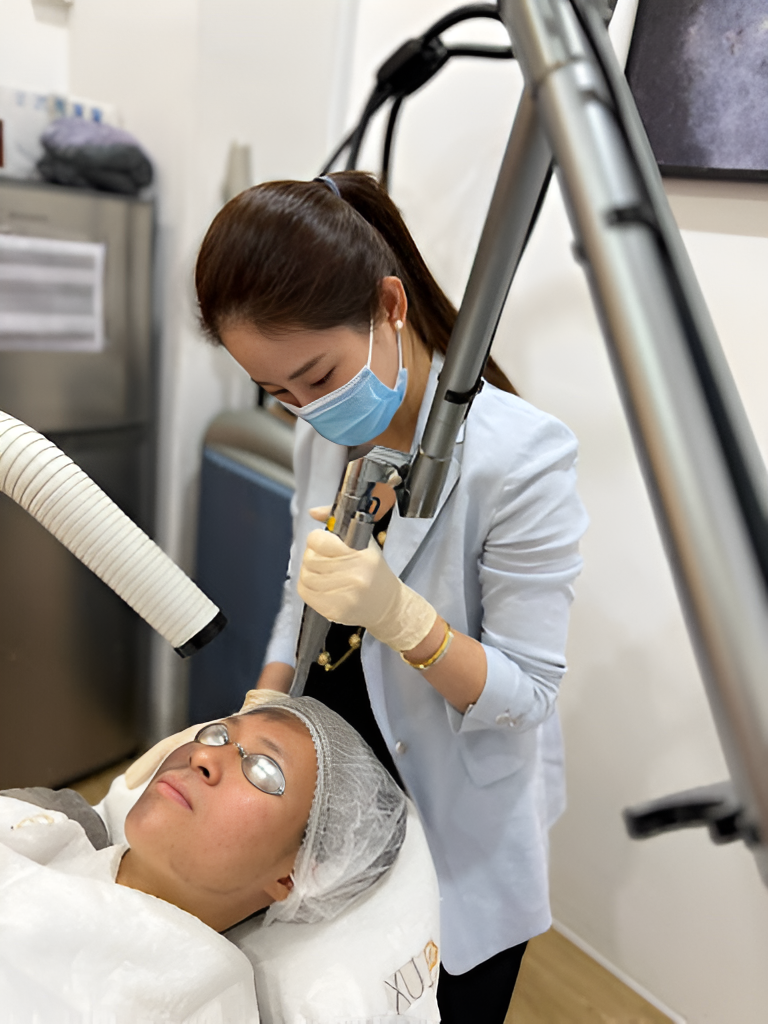
Dermal Fillers
Dermal fillers, also known as soft tissue fillers, are injectable substances that temporarily fill in an atrophic scar, making the skin surface appear more even. They can be an effective option for immediate, although temporary, improvement.
Subcision
Subcision is a minor surgical procedure where a needle is inserted into the skin to break up the fibrous tissue that causes atrophic scars. This encourages new collagen formation, which can help raise the depressed areas.
Polynucleotide (PN) injectables
PN such as Rejuran S can help to treat atrophic scars. It can trigger the release of growth factors to initiate skin healing. This helps to reduce the appearance of unwanted scars.
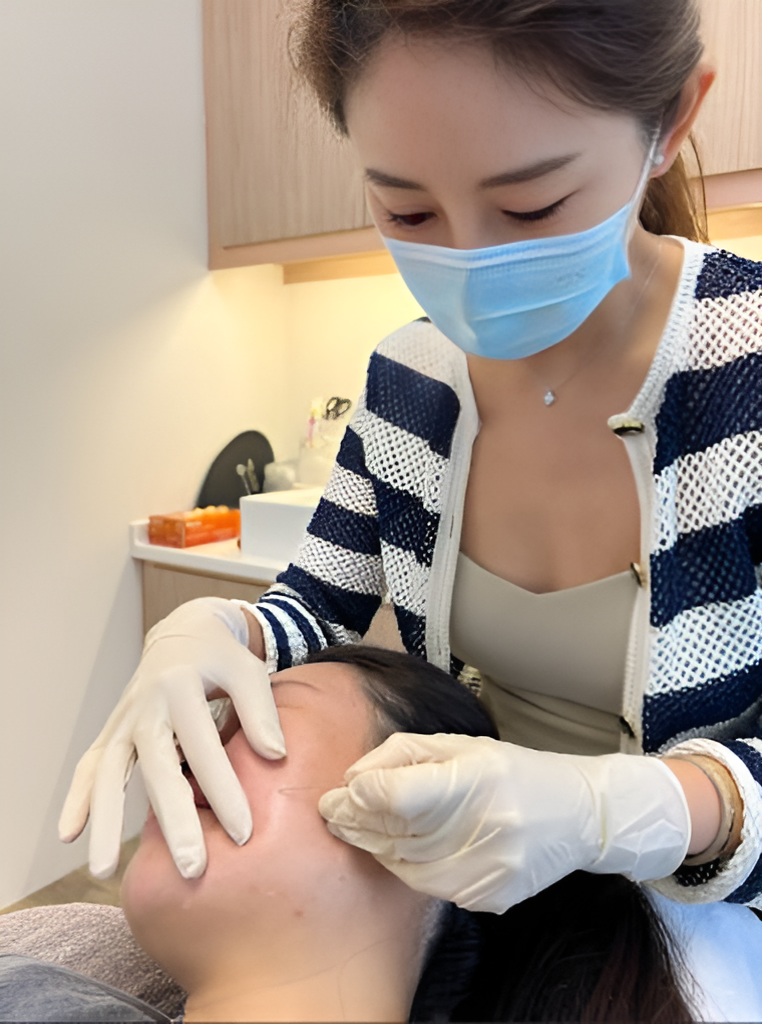
Benefits of Treating Atrophic Acne Scars
Treating atrophic acne scars can significantly improve your skin health and appearance.
Improved Skin Texture
Treatments can smooth out your skin, making it feel more even and supple.
Enhanced Confidence
A clearer, smoother complexion can boost self-esteem and confidence.
Even Skin Tone
Effective scar treatments can help you achieve a more uniform skin tone, reducing the appearance of discolouration.
Prevention of Future Scarring
Proper acne treatment and atrophic scar management can prevent future scars from forming.
Minimised Hyperpigmentation
Treatments can reduce the dark spots and discolouration often associated with atrophic scars.
5 Tips for Preventing Atrophic Acne Scars
Preventing atrophic scars involves proactive and consistent skincare practices:
1. Act Fast
Address breakouts quickly to minimise inflammation and scarring. Early treatment can reduce the inflammatory response, help the skin heal properly, and prevent damage to deeper skin layers.
2. Hands Off!
Avoid picking or squeezing acne, as this can push bacteria deeper into the skin and increase the risk of atrophic scarring.
3. Skincare for Acne
Use skincare that’s suitable for acne. Products that contain BHAs, retinols might be helpful in acne reduction. Topical creams and gels might also be useful to reduce acne quickly.
4. Sunscreen is Essential
Daily sunscreen with SPF 50+ protects the skin from UV damage, which can worsen acne and darken scars.
5. Schedule Regular Consultations
Regular consultations with a dermatologist can ensure acne is treated effectively and scars are managed properly.
Conclusion
Understanding and treating atrophic scars can transform your skin and boost your confidence. With the right approach and professional guidance, you can achieve a clearer, smoother complexion. From laser and microneedling to chemical peels and dermal fillers, different treatment options are available to address different types of atrophic scars.
Preventive measures, such as acting quickly on breakouts, maintaining a gentle skincare routine, and using sunscreen, are crucial in minimising scar formation.
For personalised advice on treating acne and managing scars, consult with us at Lux Medical Aesthetic Clinic. Our team will assess your skin and recommend treatments tailored to your needs, helping you achieve your desired results.
Acne Scars: 5 Types, Causes, Prevention, and Treatment
Acne scars are a common concern that can significantly impact one’s self-esteem, leaving many in search of solutions for clearer, smoother skin. These scars are more than just a physical reminder of past acne bouts; they can affect how people perceive themselves and how they are perceived by others.
There are several types of acne scars: atrophic scars (ice pick, boxcar, and rolling scars), and hypertrophic and keloid scars.
Many people dealing with acne scars seek clearer, smoother skin, motivated by a desire for improved appearance and boosted confidence. Since each type of acne scar—whether atrophic, hypertrophic, or keloid—requires specific approaches, understanding the nature of these scars is crucial for effective treatment.
What are Acne Scars?
Acne scars are textural changes on the skin and indentations that develop as a result of severe acne. These scars occur when the skin’s inflammatory response to acne lesions, such as pimples, damages the underlying tissue and disrupts the healing process. When a pimple heals, the skin often undergoes a complex reparative process.
Initially, the inflammation caused by the acne lesion signals the body’s immune system to start the healing process. This involves the generation of new collagen fibres that attempt to repair the skin. If the original inflammation is too intense or lasts for an extended period, it can disrupt this process, leading to the formation of scars.
During this inflammatory response, the body produces collagen to repair the damaged skin. However, if the body produces too little or too much collagen, it can result in atrophic scars (depressions in the skin) or hypertrophic scars (raised areas on the skin), respectively.
How common is acne scarring? More than 90% of people experiencing acne develop acne scarring.
Types of Acne Scars
Understanding the different types of acne scars can help in finding the most effective treatment.
Rolling scars
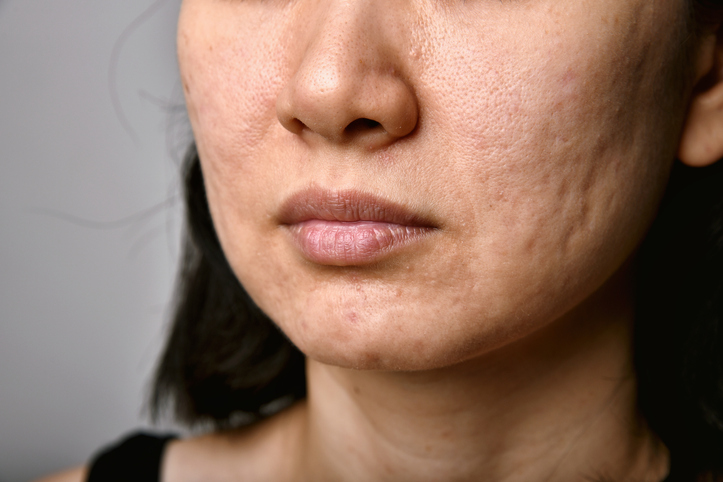
Rolling scars appear as shallow, wavy indentations on the skin. They are typically caused by damage under the skin’s surface, leading to an uneven appearance.
Ice pick scars
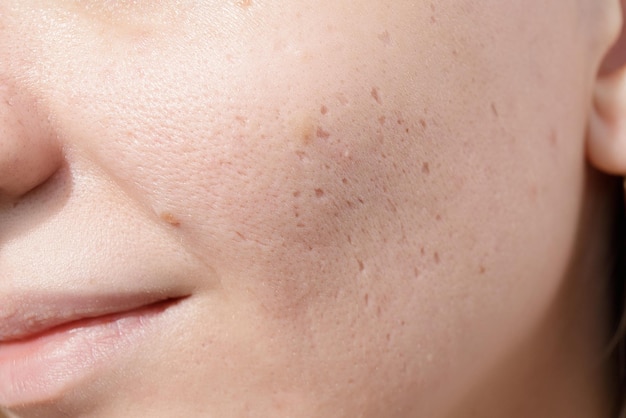
Ice pick scars are narrow, deep pits that resemble tiny, sharp indentations. These are deeper scars, making them more challenging to treat.
Boxcar Scars
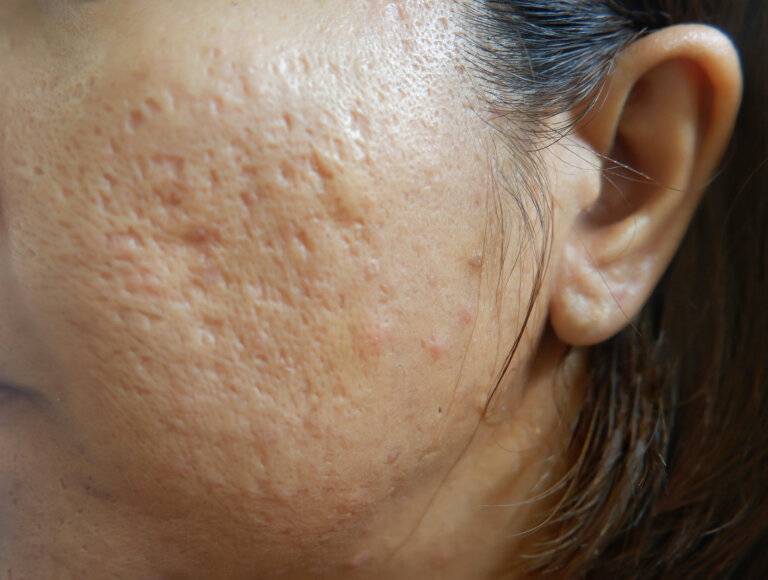
Boxcar scars are characterised by square or rectangular depressions with sharp edges. These scars often result from severe acne and give the skin a pitted look.
Atrophic Scars

Atrophic scars are skin depressions that result from the lack of collagen during wound healing.
Hypertrophic and Keloid Scars
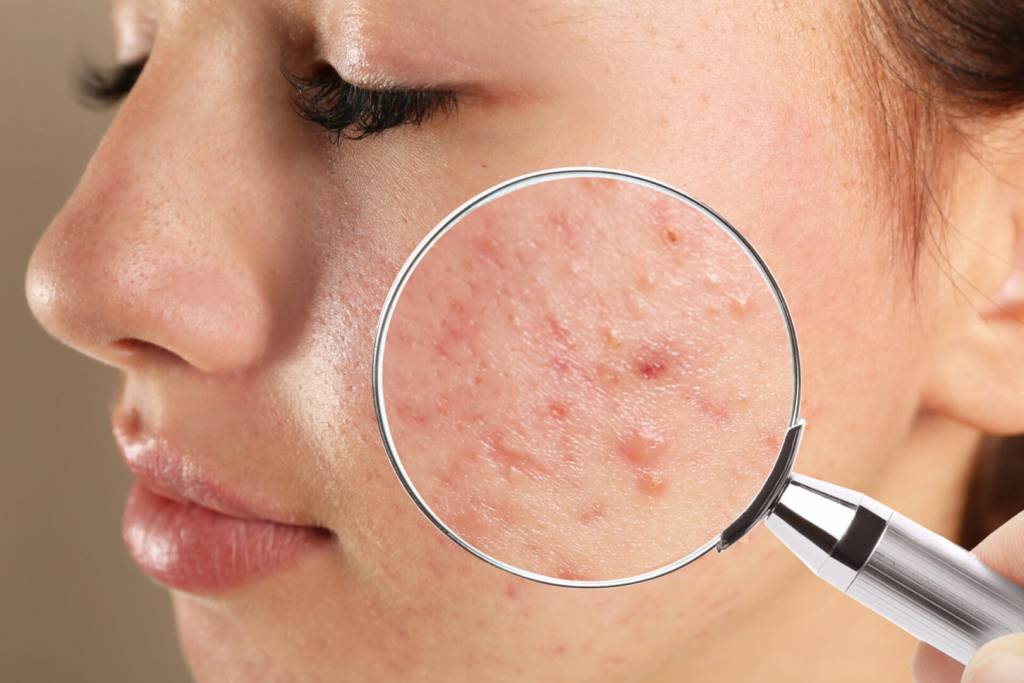
Hypertrophic and keloid scars manifest as raised, red scar tissue, but they differ in their appearance and growth patterns. Hypertrophic scars remain within the boundaries of the original wound, while keloid scars extend beyond the area of injury. These raised scars are a result of an excessive production of collagen during the healing process. When the body produces too much collagen, it can lead to the formation of either hypertrophic or keloid scars, depending on the individual’s skin type and healing response.
Causes of Acne Scars
Acne scars primarily result from severe acne and the habit of picking at pimples.
When acne is particularly intense, it often penetrates deep into the skin, causing damage that the body attempts to repair. However, this repair process can be imperfect, leading to the formation of scars. Picking or squeezing pimples exacerbates this issue by further damaging the skin and increasing the risk of infection and inflammation.
Inflammation also causes the formation of acne scars. When the skin tissue becomes inflamed, the body deploys its defence mechanisms, including white blood cells and other substances aimed at healing the affected area. However, this process can sometimes go overboard, resulting in the destruction of surrounding skin tissues and leading to scars.
Acne scarring may also be due to genetics and skin type. Some individuals are more predisposed to scarring due to their genetic makeup. Additionally, certain skin types, particularly those that easily discolour or have a tendency for hyperpigmentation, are more susceptible to scarring.
Prevention Tips for Acne Scars
Acne scars can be frustrating, but strategies are available to reduce their occurrence and severity. Here are some practical prevention tips:
1. Proper Acne Management Routine:
Maintaining a consistent skincare routine is crucial. Use a gentle cleanser to remove excess oil and dirt from the skin without stripping it, and hydrate it with an oil-free moisturiser, as dry skin can aggravate acne.
2. Use Non-Comedogenic Products:
Choose skincare and cosmetic products that are labelled ‘non-comedogenic’. These formulated products do not clog pores, reducing the potential for acne breakouts and subsequent scarring.
3. Avoid Picking at Pimples:
As tempting as it might be, picking at pimples can lead to increased inflammation and scar formation. Apply a spot treatment instead, and let the pimple heal naturally.
4. Lifestyle Adjustments:

Make sure to eat a balanced diet, get adequate sleep, and stay hydrated. Exercise also reduces stress, which is a known trigger for acne.
5. Seek Professional Help for Persistent Acne:
If acne persists despite home care, consider consulting a doctor. They can provide treatments such as topical or oral medications, as well as other therapies to control acne and prevent scarring.
How can I reduce my risk of acne scars? To reduce the risk of acne scars, follow a good skincare routine diligently, avoid picking or squeezing pimples, and use non-comedogenic products to prevent clogs in your pores. Also, observe a balanced diet, proper hydration, and stress management.
The Importance of Consistency
Consistency in your skincare routine ensures that your skin remains balanced, free of excess oil, and less prone to breakouts. By consistently using products that are suited to your skin type, you allow your skin to benefit fully from their active ingredients, leading to better overall skin health.
This disciplined approach helps reduce the chances of severe acne that could lead to scarring, making it an essential aspect of any effective skincare strategy.
Treatment Options for Acne Scars
Treatment options span from in-office procedures and surgical interventions. It’s essential to understand the different approaches to find the best one suitable for your specific needs. Consulting a doctor is crucial as they can provide a personalised treatment plan.
In-office Procedures
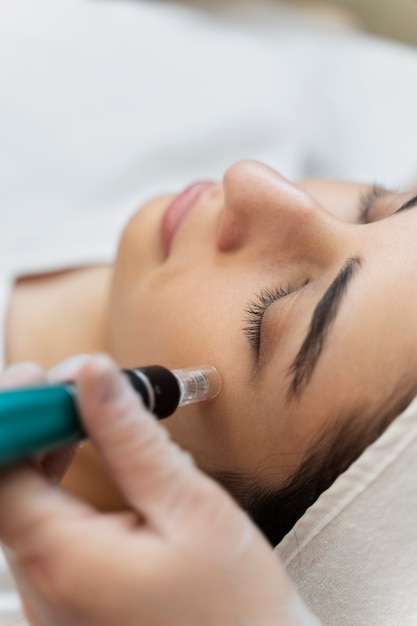
TCA Cross Chemical Peels:
The TCA Cross technique is commonly used specifically for treating ice pick scars.
This procedure typically takes 5 to 10 minutes, depending on the number of scars being treated. Repeated sessions may be required for optimal results. This procedure usually involves downtime of up to a week. The full results from a single procedure may take up to 3-6 months to show as the skin continues to heal and remodel collagen in the treated areas.
Intracel RF Microneedling:
Intracel RF Microneedling involves using tiny needles in a device to create micro-injuries in the skin. The tips of these microneedles produce radiofrequency which further helps to stimulate collagen growth. This process stimulates the body’s natural healing response to encourage new collagen and elastin production, which can improve skin texture and reduce scarring.
This procedure typically takes about 20- 30 minutes, and patients may experience mild redness of the skin for 2 to 3 days after the treatment. Results can be seen after 1 to 3 months, as the body will take time to stimulate collagen production and smoothen the skin.
Fractional CO2 Laser:
Fractional CO2 laser is a popular procedure for treating and resurfacing acne scars. This method uses an ablative laser in a grid-like pattern on the skin, where the skin between the treated areas serves as a reservoir that contains healthy tissue to promote healing.
The laser beams reach the correct layers of skin, causing a reaction to resurface, remodel and regenerate collagen that repairs acne scars. A topical numbing cream is usually applied to make the procedure more comfortable for you.
This treatment takes approximately 10 to 15 minutes, and patients might feel slight tingling and mild redness after. In 2-3 days, micro- scabs will form and this typically takes 7-9 days to fully heal. It is recommended not to pick on the scabs and allow them to drop off naturally. The Fractional Co2 laser can be done 5 to 10 more times for better results, with treatments spaced about a month apart.
Subcision:
Subcision disrupts the acne scar tissue under the skin and separates it by using a needle. A needle is placed into each individual scar and is used to subcise stubborn scars to smoothen it further. There might be some bleeding during the treatment. Temporary bruising and needle marks can be expected after the treatment. This procedure comes with a downtime of 5-7 days. Repeated sessions may be required for better results.
PDRN S Injections:
PDRN S is an injection containing polynucleotides to treat acne scars. It is injected into the base of the scar to repair skin, promote healing, and stimulate cells to produce collagen.
This procedure can be done together with subcission.
There may be small bumps in the treated area after the procedure. The bumps will usually resolve in 1-3 days. Your skin will typically recover from needle marks within 5-7 days.
Scar Excision:
For more severe acne scars, surgical options such as scar excision might be recommended. This procedure involves removing the scar tissue entirely and then closing the area with stitches, resulting in a smaller, less visible scar.
Fillers:
Dermal fillers work by filling in the indented scars, helping to smooth out the surface of the skin. This does not fully remove the appearance of the scars but rather, it makes the scar appear less obvious or sunken. Fillers provide immediate results, although they are not a permanent solution and might require repeat treatments. Typically results last about 6-9 months before the procedure will have to be repeated again.
Importance of Consulting a Dermatologist
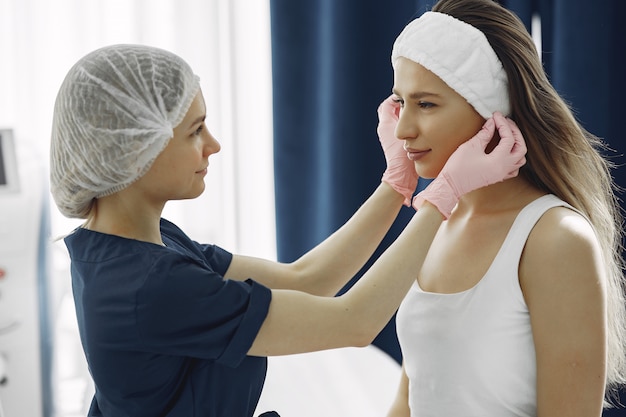
Successfully treating acne scars often requires a combination of different approaches. A doctor will evaluate the type of scars you have and recommend the ideal treatment for your acne scars.
With the right guidance and treatment, significant improvements in the appearance of acne scars are entirely possible.
When to See a Doctor?
There are certain situations where consulting a doctor becomes essential. If your scars are causing significant emotional distress or if your scars are deep or widespread, it’s important to seek professional help.
A doctor can assess the scars and recommend suitable treatment options, which may include microneedling, laser therapy, or surgical procedures.
Living with Acne Scars
Living with acne scars can have a profound psychological impact, influencing various facets of an individual’s life.
One of the most significant effects is a reduction in self-confidence. People with prominent acne scars might feel less attractive or worry excessively about their skin’s appearance, often diminishing their self-esteem. This decreased self-confidence can lead to social anxiety, as individuals might fear judgement or ridicule from others.
Social interactions, once a source of joy, could become stress-inducing events that are avoided whenever possible. Moreover, feeling self-conscious about one’s appearance can create a constant inner dialogue of self-criticism, affecting both personal and professional relationships.
Understanding this psychological burden is crucial in fostering a more empathetic and supportive environment for those coping with acne scars.
Acne scars can manifest in various forms, from atrophic scars like ice pick and boxcar scars to hypertrophic and keloid scars. You can prevent acne scars by treating acne early, avoiding picking or squeezing pimples, and using appropriate skincare products.
Numerous treatment options exist to reduce the appearance of acne scars. These include in-office procedures such as TCA cross chemical peels, Intracel RF Microneedling, and Fractional Co2 laser resurfacing, PDRN injections, as well as dermal fillers.
The possibility of achieving smoother skin is not only hopeful but also realistic with the right treatment approach and professional guidance. Advances in dermatological treatments mean that even severe acne scars can see significant improvement. With patience and perseverance, clearer and more radiant skin is within reach.
